Petrogenesis and Tectonic Implications of the Early Cretaceous Granitic Pluton in the Sulu Orogenic Belt: The Caochang Granitic Pluton as an Example
Abstract
1. Introduction
2. Regional Geological Setting and Petrological Features
3. Methods
3.1. Zircon U-Pb Geochronology and Oxygen Isotope Analyses
3.2. Zircon Lu–Hf Isotopes
3.3. Major and Trace Whole-Rock Elements
4. Results
4.1. Zircon U-Pb Dating Results
4.2. Zircon Hf–O Isotopic Results.
4.3. Whole-Rock Geochemical Results
5. Discussion
5.1. Classification for the Granitic Pluton
5.2. Magma Source and Petrogenesis
5.3. Mineral Fractional Crystallization
5.4. Evaluation on the Adakite-Like Rocks
5.5. Tectonic Implications
6. Concluding Remarks
Author Contributions
Funding
Conflicts of Interest
References
- Yang, J.H.; Chung, S.L.; Wilde, S.A.; Wu, F.Y.; Chu, M.F.; Lo, Q.H.; Fan, H.R. Petrogenesis of post-orogenic syenites in the Sulu Orogenic Belt, East China: Geochronological, geochemical and Nd-Sr isotopic evidence. Chem. Geol. 2005, 214, 99–125. [Google Scholar] [CrossRef]
- Yang, J.H.; Wu, F.Y.; Chung, S.L.; Wilde, S.A.; Chu, M.F.; Lo, C.H.; Song, B. Petrogenesis of Early Cretaceous intrusions in the Sulu ultrahigh-pressure orogenic belt, East China and their relationship to lithospheric thinning. Chem. Geol. 2005, 222, 200–231. [Google Scholar] [CrossRef]
- Liu, F.L.; Liu, L.S.; Liu, P.H.; Wang, F.; Cai, J.; Liu, J.H.; Wang, W.; Ji, L. A relic slice of Archean-early Paleoproterozoic basement of Jiaobei Terrane identified within the Sulu UHP belt: Evidence from protolith and metamorphic ages from meta-mafic rocks, TTG-granitic gneisses, and metasedimentary rocks in the Haiyangsuo region. Precambrian Res. 2017, 303, 117–152. [Google Scholar] [CrossRef]
- Zhao, Z.F.; Liu, Z.B.; Chen, Q. Melting of subducted continental crust: Geochemical evidence from Mesozoic granitoids in the Dabie-Sulu orogenic belt, east-central China. J. Asian Earth Sci. 2017, 145, 260–277. [Google Scholar] [CrossRef]
- Zhao, Z.F.; Zheng, Y.F. Remelting of subducted continental lithosphere: Petrogenesis of Mesozoicmagmatic rocks in the Dabie-Sulu orogenic belt. Sci. China Ser. D 2009, 52, 1295–1318. [Google Scholar] [CrossRef]
- Xu, Y.; Yang, M.L.; Polat, A.; Yang, K.G.; Meng, Y.K.; Li, R.H.; Wang, Z.B. Zircon U-Pb ages and Hf isotopic compositions of two types of supracrustal rocks in the Northeastern Sulu UHP terrane: Constraints on the surface boundary between South China and North China. Int. Geol. Rev. 2018, 61, 539–561. [Google Scholar] [CrossRef]
- Wang, S.J.; Schertl, H.P.; Pang, Y.M. Geochemistry, geochronology and Sr-Nd-Hf isotopes of two types of early cretaceous granite porphyry dykes in the Sulu Orogenic Belt, Eastern China. Can. J. Earth Sci. 2019, 57, 249–266. [Google Scholar] [CrossRef]
- Zheng, Y.F. A perspective view on ultrahigh-pressure metamorphism and continental collision in the Dabie-Sulu orogenic belt. Chin. Sci. Bull. 2008, 53, 3081–3104. [Google Scholar] [CrossRef]
- Liou, J.G.; Ernst, W.G.; Zhang, R.Y.; Tsujimori, T.; Jahn, B.M. Ultrahigh-pressure minerals and metamorphic terranes-the view from China. J. Asian Earth Sci. 2009, 35, 199–231. [Google Scholar] [CrossRef]
- Zheng, Y.F.; Fu, B.; Gong, B.; Li, L. Stable isotope geochemistry of ultrahigh pressure metamorphic rocks from the Dabie–Sulu orogeny in China: Implications for geodynamics and fluid regime. Earth Sci. Rev. 2003, 62, 105–161. [Google Scholar] [CrossRef]
- Meng, Y.K.; Santosh, M.; Li, R.H.; Xu, Y.; Hou, F.H. Petrogenesis and tectonic implications of Early Cretaceous volcanic rocks from Lingshan Island in the Sulu Orogenic Belt. Lithos 2018, 312–313, 244–257. [Google Scholar] [CrossRef]
- Wang, H.; Wang, S.H.; Xu, Z.W.; Fu, B.; Zhao, Z.X.; Li, Z.G.; Dong, Y.H.; Tang, L.M.; Li, J. Geochemical and Sr-Nd-Pb-Hf-O isotopic compositions of the Tiezhai complex: Implications for lithosphere destruction of the North China Craton. Gondwana Res. 2018, 61, 203–221. [Google Scholar] [CrossRef]
- Wang, J.; Chang, S.C.; Chen, Y.; Yan, S.Y. Early Cretaceous transpressional and transtensional tectonics straddling the Sulu orogenic belt, East China. Geosci. Front. 2019, 10, 2287–2300. [Google Scholar] [CrossRef]
- Xu, H.J.; Zhang, J.F.; Wang, Y.F.; Liu, W.L. Late Triassic alkaline complex in the Sulu UHP terrane: Implication for post-collisional magmatism and subsequent fractional crystallization. Gondwana Res. 2016, 35, 390–410. [Google Scholar] [CrossRef]
- Zhao, Z.F.; Zheng, Y.F.; Zhang, J.; Dai, L.Q.; Liu, X.M. Syn-exhumation magmatism during continental collision: Evidence from alkaline intrusives of Triassic age in the Sulu orogen. Chem. Geol. 2012, 328, 70–88. [Google Scholar] [CrossRef]
- Jahn, B.M.; Wu, F.Y.; Lo, C.H.; Tsai, C.H. Crust-mantle interaction induced by deep subduction of the continental crust: Geochemical and Sr-Nd isotopic evidence from post-collisional mafic-ultramafic intrusions of the northern Dabie complex, central China. Chem. Geol. 1999, 157, 119–146. [Google Scholar] [CrossRef]
- Zhou, X.M.; Li, W.X. Origin of Late Mesozoic igneous rocks of southeastern China: Implications for lithosphere subduction and underplating of mafic magma. Tectonophysics 2000, 326, 269–287. [Google Scholar] [CrossRef]
- Zhao, Z.F.; Zheng, Y.F.; Chen, Y.X.; Sun, G.C. Partial melting of subducted continental crust: Geochemical evidence from synexhumation granite in the Sulu orogen. Geol. Soc. Am. Bull. 2017, 129, 1692–1707. [Google Scholar] [CrossRef]
- Niu, Y.L.; Liu, Y.; Xue, Q.Q.; Shao, F.L.; Chen, S.; Duan, M.; Guo, P.Y.; Gong, H.M.; Hu, Y.; Hu, Z.X.; et al. The exotic origin of the continental shelf of East and South China Seas-a testable hypothesis with consequences on the tectonic evolution of the western Pacific and eastern China since the Mesozoic. Sci. Bull. 2015, 18, 1598–1616. [Google Scholar] [CrossRef]
- Gao, Y.J.; Niu, Y.L.; Duan, M.; Xue, Q.Q.; Sun, P.; Chen, S.; Xiao, Y.Y.; Guo, P.Y.; Wang, X.H.; Chen, Y.H. The petrogenesis and tectonic significance of the Early Cretaceous intraplate granites in eastern China: The Laoshan granite as an example. Lithos 2019, 328–329, 200–211. [Google Scholar] [CrossRef]
- Dai, L.Q.; Zheng, Y.F.; Zhao, Z.F. Termination time of peak decratonization in North China: Geochemical evidence from mafic igneous rocks. Lithos 2016, 240–243, 327–336. [Google Scholar] [CrossRef]
- Ling, M.X.; Li, Y.; Ding, X.; Teng, F.Z.; Yang, X.Y.; Fan, W.M.; Xu, Y.G.; Sun, W.D. Destruction of the North China Craton induced by ridge subductions. J. Geol. 2013, 121, 197–213. [Google Scholar] [CrossRef]
- Yan, Q.S.; Shi, X.F. Geochemistry and petrogenesis of the Cretaceous A-type granites in the Laoshan granitic complex, eastern China. Island Arc 2014, 23, 221–235. [Google Scholar] [CrossRef]
- Zhang, J.; Zhao, Z.F.; Zheng, Y.F.; Dai, M.N. Postcollisional magmatism: Geochemical constraints on the petrogenesis of Mesozoic granitoids in the Sulu orogen, China. Lithos 2010, 119, 512–536. [Google Scholar] [CrossRef]
- Zhang, J.; Zhao, Z.F.; Zheng, Y.F.; Liu, X.M.; Xie, L.W. Zircon Hf–O isotope and whole-rock geochemical constraints on origin of postcollisional mafic to felsic dykes in the Sulu orogen. Lithos 2012, 136, 225–245. [Google Scholar] [CrossRef]
- Meng, Y.K.; Li, R.H.; Xu, Y.; Hou, F.H. U-Pb-Hf isotopes and tectonic significance of early Cretaceous detrital zircons on Lingshan Island, Qingdao of Shandong Province. Earth Sci. 2018, 43, 3302–3323. [Google Scholar]
- Zhou, J.B.; Wilde, S.A.; Zhao, G.C.; Zhang, X.Z.; Zheng, C.Q.; Jin, W.; Cheng, H. SHRIMP U–Pb zircon dating of theWulian complex: Defining the boundary between the north and south China cratons in the Sulu orogenic belt, China. Precambrian Res. 2008, 162, 559–576. [Google Scholar] [CrossRef]
- Zhou, J.B.; Wilde, S.; Zhao, G.C.; Zheng, C.Q.; Jin, W.; Zhang, X.Z.; Cheng, H. SHRIMP U-Pb zircon dating of the Neoproterozoic Penglai Group and Archean gneisses from the Jiaobei terrane, north China, and their tectonic implications. Precambrian Res. 2008, 160, 323–340. [Google Scholar] [CrossRef]
- Guo, J.H.; Chen, F.K.; Zhang, X.M.; Siebel, W.; Zhai, M.G. Evolution of syn- to post-collisional magmatism from north Sulu UHP belt, eastern China: Zircon U-Pb geochronology. Acta Petrol. Sin. 2005, 21, 1281–1301. [Google Scholar]
- Liu, Y.S.; Hu, Z.C.; Zong, K.Q.; Gao, C.G.; Gao, S.; Xu, J.; Chen, H.H. Reappraisement and refinement of zircon U-Pb isotope and trace element analyses by LA-ICP-MS. Chin. Sci. Bull. 2010, 55, 1535–1546. [Google Scholar] [CrossRef]
- Zong, K.Q.; Liu, Y.S.; Gao, C.G.; Hu, Z.H.; Gao, S.; Gong, H.J. In situ U-Pb dating and trace element analysis of zircons in thin sections of eclogite: Refining constraints on the UHP metamorphism of the Sulu terrane, China. Chem. Geol. 2010, 269, 237–251. [Google Scholar] [CrossRef]
- Williams, I.S. U-Th-Pb geochronology by ion microprobe. In Applications of Microanalytical Techniques to Understanding Mineralizing Processes; McKibben, M.A., Shanks, W.C., Ridley, W.I., Eds.; Review of Economic Geology; Society of Economic Geologists: Littleton, CO, USA, 1998; Volume 7, pp. 1–35. [Google Scholar]
- Black, L.P.; Kamo, S.L.; Allen, C.M.; Davis, D.W.; Aleinikoff, J.N.; Valley, J.W.; Mundil, R.; Campbell, I.H.; Korsch, R.J.; Williams, I.S.; et al. Improved 206Pb/238U microprobe geochronology by the monitoring of a trace-element related matrix effect; SHRIMP, ID-TIMS, ELA-ICP-MS and oxygen isotope documentation for a series of zircon standards. Chem. Geol. 2004, 205, 115–140. [Google Scholar] [CrossRef]
- Hu, Z.C.; Liu, Y.S.; Gao, S.; Liu, W.G.; Yang, L.; Zhang, W.; Tong, X.R.; Lin, L.; Zong, K.Q.; Li, M.; et al. Improved in situ Hf isotope ratio analysis of zircon using newly designed X skimmer cone and Jet sample cone in combination with the addition of nitrogen by laser ablation multiple collector ICP-MS. J. Anal. At. Spectrom. 2012, 27, 1391–1399. [Google Scholar] [CrossRef]
- Hoskin, P.W.O.; Schaltegger, U. The composition of zircon and igneous and metamorphic petrogenesis. Rev. Mineral. Geochem. 2003, 53, 27–62. [Google Scholar] [CrossRef]
- Andersen, T. Correction of common lead in U-Pb analyses that do not report 204Pb. Chem. Geol. 2002, 192, 59–79. [Google Scholar] [CrossRef]
- Xiong, F.H.; Meng, Y.K.; Yang, J.S.; Liu, Z.; Xu, X.Z.; Eslami, A.; Zhang, R. Geochronology and petrogenesis of the mafic dykes from the Purang ophiolite: Implications for evolution of the western Yarlung-Tsangpo suture zone, Tibet. Geosci. Front. 2020, 11, 277–292. [Google Scholar] [CrossRef]
- Middlemost, E.A.K. Naming materials in the magma/igneous rock system. Earth-Sci. Rev. 1994, 37, 215–224. [Google Scholar] [CrossRef]
- Irvine, T.N.; Baragar, W.R.A. A guide to the chemical classification of the common volcanic rocks. Can. J. Earth Sci. 1971, 8, 523–548. [Google Scholar] [CrossRef]
- Wright, J.B. A simple alkalinity ratio and its application to questions of non-orogenic granite genesis. Geol. Mag. 1969, 106, 370–384. [Google Scholar] [CrossRef]
- Peccerillo, A.; Taylor, S.R. Geochemistry of Eocene calc-alkaline volcanic rocks from the Kastamonu area, northern Turkey. Contrib. Miner. Petrol. 1976, 58, 63–81. [Google Scholar] [CrossRef]
- Maniar, P.D.; Piccoli, P.M. Tectonic discrimination of granitoids. Geol. Soc. Am. Bull. 1989, 101, 635–643. [Google Scholar] [CrossRef]
- Moyen, J.F. High Sr/Y and La/Yb ratios: The meaning of the adakitic signature. Lithos 2009, 112, 556–574. [Google Scholar] [CrossRef]
- Sun, T.; Zhou, X.M.; Chen, P.R.; Li, H.M.; Zhou, H.Y.; Wang, Z.C.; Shen, W.Z. Mesozoic strong peraluminous granite and its tectonic significance in the eastern Nanling Mountains, China. Sci. China Ser. D 2003, 33, 1209–1218. [Google Scholar]
- Boynton, W.V. Geochemistry of the rare earth elements: Meteorite studies. In Rare Earth Element Geochemistry; Henderson, P., Ed.; Elsevier: Amsterdam, The Netherlands, 1984; pp. 63–114. [Google Scholar]
- Sun, S.S.; McDonough, W.F. Chemical and isotopic systematics of oceanic basalts: Implications for mantle composition and processes. In Magmatism in the Ocean Basins; Saunders, A.D., Norry, M.J., Eds.; Geological Society of London Special Publications: London, UK, 1989; Volume 42, pp. 313–345. [Google Scholar]
- Chappell, B.W.; White, A.J.R. Two contrasting granite types. Pac. Geol. 1974, 8, 173–174. [Google Scholar]
- Loiselle, M.C.; Wones, D.R. Characteristics and origin of anorogenic granites. Geol. Soc. Am. Abstr. 1979, 11, 468. [Google Scholar]
- Hao, L.L.; Wang, Q.; Wyman, D.A.; Ma, L.; Wang, J.; Xia, X.P.; Qu, Q. First identification of postcollisional A-type magmatism in the Himalayan-Tibetan orogen. Geology 2019, 47, 187–190. [Google Scholar] [CrossRef]
- Zhu, R.X.; Yang, J.H.; Wu, F.Y. Timing of destruction of the North China Craton. Lithos 2012, 149, 51–60. [Google Scholar] [CrossRef]
- Watson, E.B.; Wark, D.A.; Thomas, J.B. Crystallization thermometers for zircon and rutile. Contrib. Mineral. Petrol. 2006, 151, 413–433. [Google Scholar] [CrossRef]
- Zhao, G.T.; Wang, D.Z.; Cao, Q.C. The geochemistry and genesis of the Laoshan Granitoids, Shandong Province. Geol. J. China Univ. 1997, 3, 1–15. [Google Scholar]
- Whalen, J.B.; Currie, K.L.; Chappell, B.W. A-type granites: Geochemical characteristics, discrimination and petrogenesis. Contrib. Miner. Petrol. 1987, 95, 407–419. [Google Scholar] [CrossRef]
- Chappell, B.W.; White, A.J.R. I- and S-type granites in the Lachlan Fold Belt. Transactions of the Royal Society of Edinburgh: Earth Sci. 1992, 83, 1–26. [Google Scholar] [CrossRef]
- Chappell, B.W. Aluminium saturation in I- and S-type granites and the characterization of fractionated haplogranites. Lithos 1999, 46, 535–551. [Google Scholar] [CrossRef]
- Zhang, S.B.; Zheng, Y.F. Time and space of Neoproterozoic low δ18O magmatic rocks in South China. Chin. Sci. Bull. 2013, 58, 2344–2350. [Google Scholar]
- Gao, P.; Zheng, Y.F.; Zhao, Z.F. Distinction between S-type and peraluminous I-type granites: Zircon versus whole-rock geochemistry. Lithos 2016, 258, 77–91. [Google Scholar] [CrossRef]
- Lu, Y.H.; Gao, P.; Zhao, Z.F.; Zheng, Y.F. Whole-rock geochemical and zircon Hf-O isotopic constraints on the origin of granitoids and their mafic enclaves from the Triassic Mishuling pluton in West Qinling, central China. J. Asian Earth Sci. 2019, 189, 104136. [Google Scholar] [CrossRef]
- Zhao, R.; Wang, Q.F.; Liu, X.F.; Wang, W.; Pan, R.G. Architecture of the Sulu crustal suture between the North China Craton and Yangtze Craton: Constraints from Mesozoic granitoids. Lithos 2016, 266, 348–361. [Google Scholar] [CrossRef]
- Wu, F.Y.; Li, X.H.; Zheng, Y.F.; Gao, S. Lu-Hf isotopic systematics and their applications in petrology. Acta Petrol. Sin. 2007, 23, 185–220. [Google Scholar]
- Griffin, W.L.; Wang, X.; Jackson, S.E.; Pearson, N.J.; O’Reilly, S.Y.; Xu, X.; Zhou, X. Zircon chemistry and magmamixing, SE China: In-situ analysis of Hf isotopes, Tonglu and Pingtan igneous complexes. Lithos 2002, 61, 237–269. [Google Scholar] [CrossRef]
- Dawson, J.B.; Carswell, D.A.; Hall, J.; Wedepohl, K.H. The nature of the Lower Continental Crust; Geological Society Special Publication: London, UK, 1986; Volume 24, pp. 363–374. [Google Scholar]
- Rudnick, R.L.; Gao, S. Composition of the continental crust. Treatise Geochem. 2003, 3, 1–64. [Google Scholar]
- Valley, J.W.; Lackey, J.S.; Cavosie, A.J.; Clechenko, C.C.; Spicuzza, M.J.; Basei, M.A.S.; Bindeman, I.N.; Ferreira, V.P.; Sial, A.N.; King, E.M.; et al. 4.4 billion years of crustal maturation: Oxygen isotope ratios of magmatic zircon. Contrib. Mineral. Petrol. 2005, 150, 561–580. [Google Scholar] [CrossRef]
- Ma, Q.; Xu, Y.G.; Huang, X.L.; Zheng, J.P.; Ping, X.Q.; Xia, X.P. Eoarchean to Paleoproterozoic crustal evolution in the North China Craton: Evidence from U-Pb and Hf-O isotopes of zircons from deep-crustal xenoliths. Geochimica et Cosmochimica Acta. 2019, 278, 94–109. [Google Scholar] [CrossRef]
- Kemp, A.I.S.; Hawkesworth, C.J.; Foster, G.L.; Paterson, B.A.; Woodhead, J.D.; Hergt, J.M.; Gray, C.M.; Whitehouse, M.J. Magmatic and crustal differentiation history of granitic rocks from Hf-O isotopes in zircon. Science 2007, 315, 980–983. [Google Scholar] [CrossRef]
- Gao, S.; Yang, J.; Zhou, L.; Li, M.; Hu, Z.; Guo, J.; Yuan, H.; Gong, H.; Xiao, G.; Wei, J. Age and growth of the Archean Kongling terrain, South China, with Emphasis on 3.3 Ga granitoid gneisses. Am. J. Sci. 2011, 311, 153–182. [Google Scholar] [CrossRef]
- Guo, J.L.; Wu, Y.B.; Gao, S.; Jin, Z.M.; Zong, K.Q.; Hu, Z.C.; Chen, K.; Chen, H.H.; Liu, Y.S. Episodic Paleoarchean-Paleoproterozoic (3.3–2.0 Ga) granitoid magmatism in Yangtze craton, South China: Implications for Late Archean Tectonics. Precambrian Res. 2015, 270, 246–266. [Google Scholar] [CrossRef]
- Taylor, S.R.; Campbell, I.H.; McCulloch, M.T.; McLennan, S.M. A lower crustal origin for massif-type anorthosites. Nature 1984, 311, 372. [Google Scholar] [CrossRef]
- He, H.L.; Song, X.Y.; Zhai, M.G.; Yu, S.Y.; Du, Z.S. Lower crustal contribution to the magma formation of the Damiao massif-type anorthosite, North China Craton: Evidence from zircon Hf-O isotopes. Precambrian Res. 2019, 332, 105396. [Google Scholar] [CrossRef]
- Rapp, R.P.; Watson, E.B. Dehydration melting of metabasalt at 8–32 kbar: Implications for continental growth and crust-mantle recycling. J. Petrol. 1995, 36, 891–931. [Google Scholar] [CrossRef]
- Patiño Douce, A.E. What do experiments tell us about the relative contributions of crust and mantle to the origin of granitic magmas? In Understanding Granites: IntergratingNew and Classical Techniques; Castro, A., Fernandez, C., Vigneresse, J.L., Eds.; Special Publications, Geological Society London: London, UK, 1999; Volume 168, pp. 55–75. [Google Scholar]
- Altherr, R.; Holl, A.; Hegner, E. High-potassium, calc-alkaline I-type plutonism in the European Variscides: Northern Vosges (France) and northern Schwarzwald (Germany). Lithos 2000, 50, 51–73. [Google Scholar] [CrossRef]
- Hofmann, A.W. Chemical differentiation of the Earth: The relationship between mantle, continental crust, and oceanic crust. Earth Planet. Sci. Lett. 1988, 90, 297–314. [Google Scholar] [CrossRef]
- Schmidberger, S.S.; Hegner, E. Geochemistry and isotope systematics of calc-alkaline volcanic rocks from the Saar-Nahe basin (SW Germany): Implications for Late-Variscan orogenic development. Contrib. Mineral. Petrol. 1999, 135, 373–385. [Google Scholar] [CrossRef]
- Dostal, J.; Chatterjee, A.K. Constrasting behaviour of Nb/Ta and Zr/Hf ratios in a peraluminous granitic pluton (Nova Scotia, Canada). Chem. Geol. 2000, 163, 207–218. [Google Scholar] [CrossRef]
- Linnen, R.L.; Keppler, H. Columbite solubility in granitic melts: Consequence for the enrichment and fractionation of Nb and Ta in the Earth’s crust. Contrib. Mineral. Petrol. 1997, 128, 213–227. [Google Scholar] [CrossRef]
- Langmuir, C.H.; Vocke, R.D.; Hanson, G.N.; Hart, S.R. A general mixing equation with applications to Icelandic basalts. Earth Planet. Sci. Lett. 1978, 37, 380–392. [Google Scholar] [CrossRef]
- Yang, J.H.; Zhu, M.F.; Liu, W.; Zhai, M.G. Geochemistry and petrogenesis of Guojialing granodiorites from the northwestern Jiaodong Peninsula, eastern China. Acta Petrol. Sin. 2003, 19, 692–700. [Google Scholar]
- Zhang, H.F.; Zhai, M.G.; Tong, Y.; Peng, P.; Xu, B.L.; Guo, J.H. Petrogenesis of the Sanfoshan high-Ba-Sr granite, Jiaodong Peninsula, eastern China. Geol. Rev. 2006, 52, 43–53. [Google Scholar]
- Du, L.; Zhang, Y.Y.; Huang, Z.Y.; Li, X.-P.; Yuan, C.; Wu, B.; Long, X.P. Devonian to Carboniferous tectonic evolution of the Kangguer Ocean in the Eastern Tianshan, NW China: Insights from three episodes of granitoids. Lithos 2019, 350, 105243. [Google Scholar] [CrossRef]
- Liu, J.G.; Cai, R.H.; Pearson, D.G.; Scott, J.M. Thinning and destruction of the lithospheric mantle root beneath the North China Craton: A review. Earth Sci. Rev. 2019, 196, 102873. [Google Scholar] [CrossRef]
- Petford, N.; Atherton, M. Na–rich partial melts from newly underplated basaltic crust: The Cordillera Blanca Batholith. Peru. J. Petrol. 1996, 37, 1491–1521. [Google Scholar] [CrossRef]
- Xu, J.F.; Shinjo, R.; Defant, M.J.; Wang, Q.; Rapp, R.P. Origin of Mesozoic adakitic intrusive rocks in the Ningzhen area of east China: Partialmelting of delaminated lower continental crust? Geology 2002, 30, 1111–1114. [Google Scholar] [CrossRef]
- Xu, H.J.; Ma, C.Q.; Ye, K. Early cretaceous granitoids and their implications for the collapse of the Dabie orogen, eastern China: SHRIMP zircon U-Pb dating and geochemistry. Chem. Geol. 2007, 240, 238–259. [Google Scholar] [CrossRef]
- Defant, M.J.; Drummond, M.S. Derivation of some modern arc magmas by melting of young subducted lithosphere. Nature 1990, 347, 662–665. [Google Scholar] [CrossRef]
- Richards, J.P.; Kerrich, R. Adakie-like rocks: Their diverse origins and questionable role in metallogenesis. Econ. Geol. 2007, 102, 537–576. [Google Scholar] [CrossRef]
- Xu, W.C.; Zhang, H.F.; Luo, B.J.; Guo, L.; Yang, H. Adakite-like geochemical signature produced by amphibole–dominated fractionation of arc magmas: An example from the Late Cretaceous magmatism in Gangdese belt, southern Tibet. Lithos 2015, 232, 197–210. [Google Scholar] [CrossRef]
- Chen, B.; Jahn, B.M.; Arakawa, Y.; Zhai, M.G. Petrogenesis of the Mesozoic intrusive complexes from the southern Taihang Orogen, North China Craton: Elemental and Sr-Nd-Pb isotopic constraints. Contrib. Mineral. Petrol. 2004, 148, 489–501. [Google Scholar] [CrossRef]
- Guo, F.; Nakamuru, E.; Fan, W.M.; Kobayoshi, K.; Li, C.W. Generation of Palaeocene adakitic andesites by magma mixing; Yanji Area, NE China. J. Petrol. 2007, 48, 661–692. [Google Scholar] [CrossRef]
- Jiang, N.; Liu, Y.S.; Zhou, W.G.; Yang, J.H.; Zhang, S.Q. Derivation of Mesozoic adakitic magmas from ancient lower crust in the North China craton. Geochim. Cosmochim. Acta 2007, 71, 2591–2608. [Google Scholar] [CrossRef]
- Meng, Y.K.; Xiong, F.H.; Xu, Z.Q.; Ma, X.X. Petrogenesis of Late Cretaceous mafic enclaves and their host granites in the Nyemo region of southern Tibet: Implications for the tectonic-magmatic evolution of the Central Gangdese Belt. J. Asian Earth Sci. 2019, 176, 27–41. [Google Scholar] [CrossRef]
- He, Y.S.; Li, S.G.; Hoefs, J.; Huang, F.; Liu, S.A.; Hou, Z.H. Post-collisional granitoids from the Dabie orogen: New evidence for partial melting of thickened continental crust. Geochim. Cosmochim. Acta 2011, 75, 3815–3838. [Google Scholar] [CrossRef]
- Defant, M.; Xu, J.; Kepezhinskas, P.; Wang, Q.; Zhang, Q.; Xiao, L.; Defant, M. Adakites: Some variations on a theme. Acta Petrol. Sin. 2002, 18, 129–142. [Google Scholar]
- Rudnick, R. Growing from below. Nature 1990, 347, 711–712. [Google Scholar] [CrossRef]
- Maas, R.; Nicholls, I.A.; Legg, C. Igneous and metamorphic enclaves in the S-type Deddick granodiorite, Lachlan Fold Belt, SE Australia: Petrographic, geochemical and Nd-Sr isotopic evidence for crustal melting and magma mixing. J. Petrol. 1997, 38, 815–841. [Google Scholar] [CrossRef]
- White, R.V.; Tarney, J.; Kerr, A.C.; Saunders, A.D.; Kempton, P.D.; Pringle, M.S.; Klaver, G.T. Modification of an oceanic plateau, Aruba. Dutch Caribbean: Implications for the generation of continental crust. Lithos 1999, 46, 43–68. [Google Scholar] [CrossRef]
- Kazemi, K.; Kananian, A.; Xiao, Y.L.; Sarjoughian, F. Petrogenesis of Middle-Eocene granitoids and their mafic microgranular enclaves in central Urmia-Dokhtar Magmatic Arc (Iran): Evidence for interaction between felsic and mafic magmas. Geosci. Front. 2018, 10, 705–723. [Google Scholar] [CrossRef]
- Shellnutt, J.G.; Jahn, B.M.; Dostal, J. Elemental and Sr-Nd isotope geochemistry of microgranular enclaves from peralkaline A-type granitic plutons of the Emeishan large igneous province, SW China. Lithos 2010, 119, 34–46. [Google Scholar] [CrossRef]
- Barbarin, B. Mafic magmatic enclaves and mafic rocks associated with some granitoids of the central Sierra Nevada batholith, California: Nature, origin, and relations with the hosts. Lithos 2005, 88, 155–177. [Google Scholar] [CrossRef]
- Charles, N.; Gumiaux, C.; Augier, R.; Chen, Y.; Zhu, R.; Lin, W. Metamorphic core complexes vs. synkinematic plutons in continental extension setting: Insights from key structures (Shandong Province, eastern China). J. Asian Earth Sci. 2011, 40, 261–278. [Google Scholar] [CrossRef]
- Charles, N.; Augier, R.; Gumiaux, C.; Monié, P.; Chen, Y.; Faure, M.; Zhu, R. Timing, duration and role of magmatism in wide rift systems: Insights from the Jiaodong Peninsula (China, East Asia). Gondwana Res. 2013, 24, 412–428. [Google Scholar] [CrossRef]
- Wang, J.; Chang, S.C.; Wang, K.L.; Lu, H.B.; Zhang, H.C. Geochronology and geochemistry of early cretaceous igneous units from the central Sulu orogenic belt: Evidence for crustal delamination during a shift in the regional tectonic regime. J. Asian Earth Sci. 2015, 112, 49–59. [Google Scholar] [CrossRef]
- Zhu, R.X.; Xu, Y.G. The subduction of the west Pacific plate and the destruction of the north China craton. Sci. China Earth Sci. 2019, 62, 1340–1350. [Google Scholar] [CrossRef]
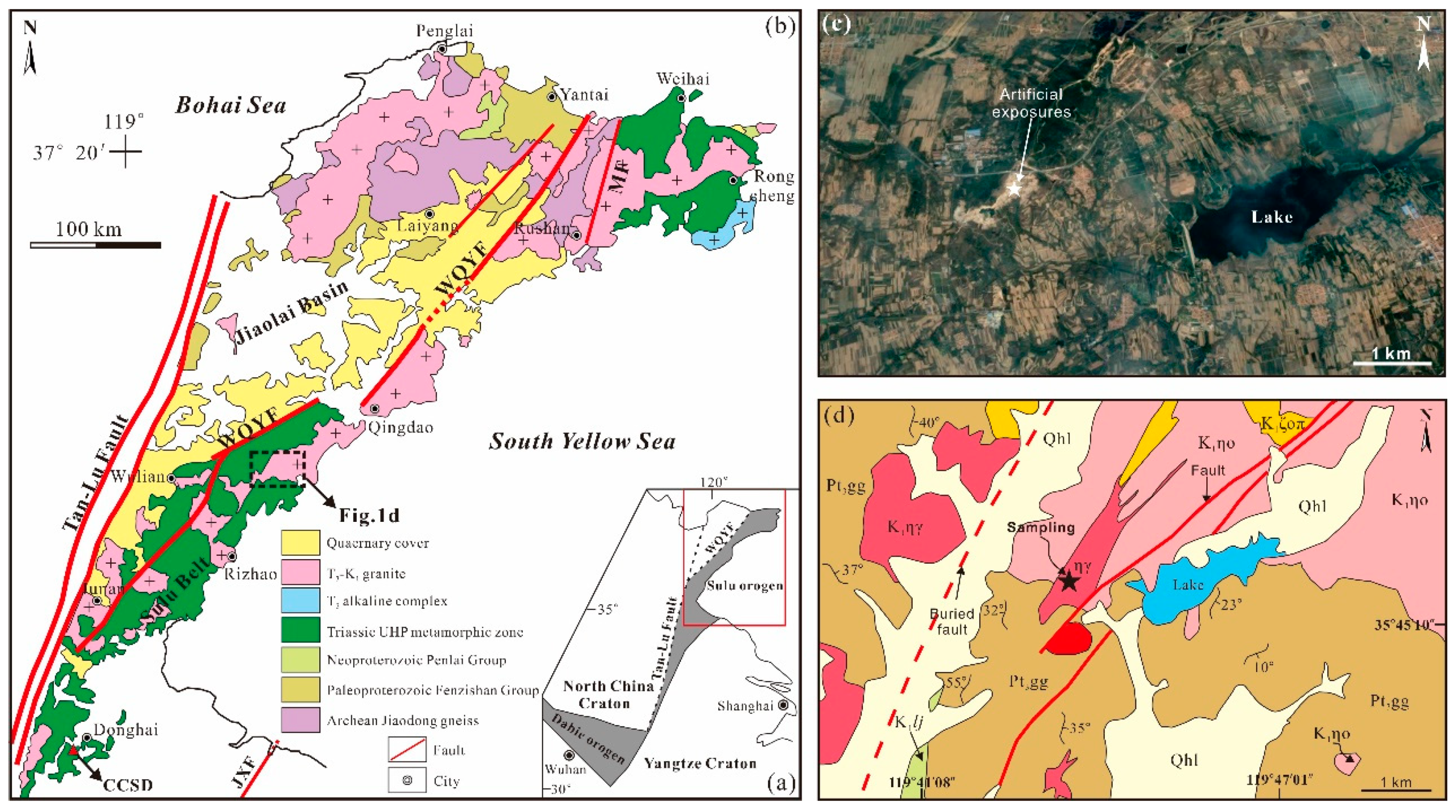
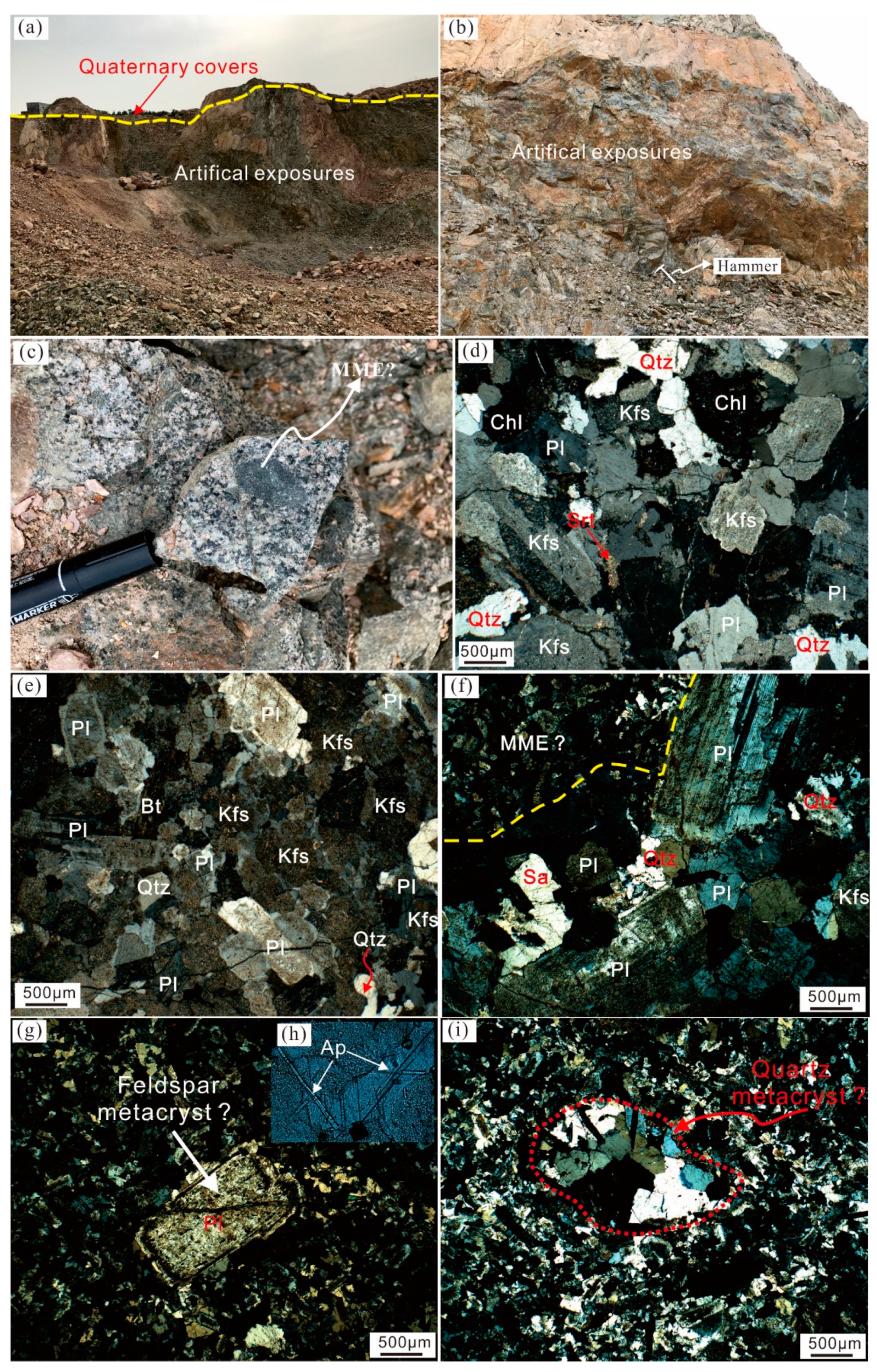
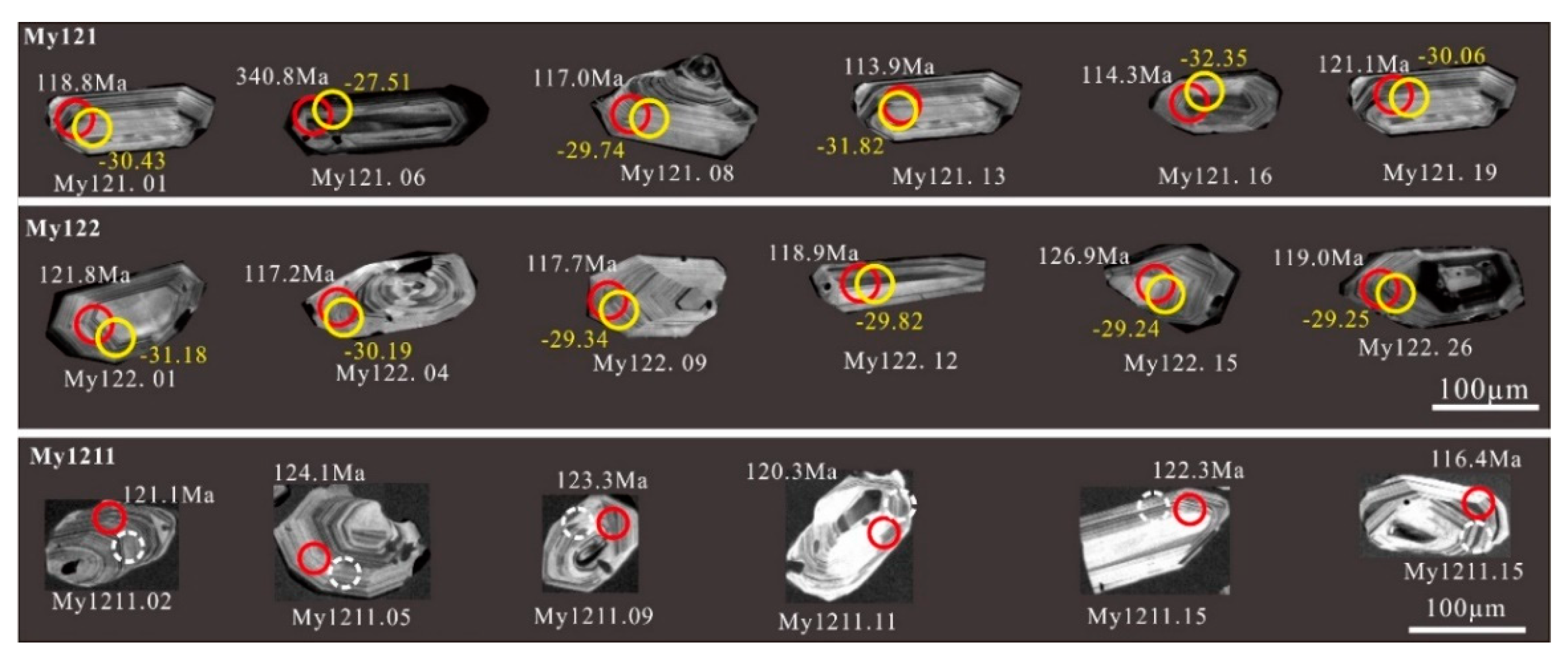
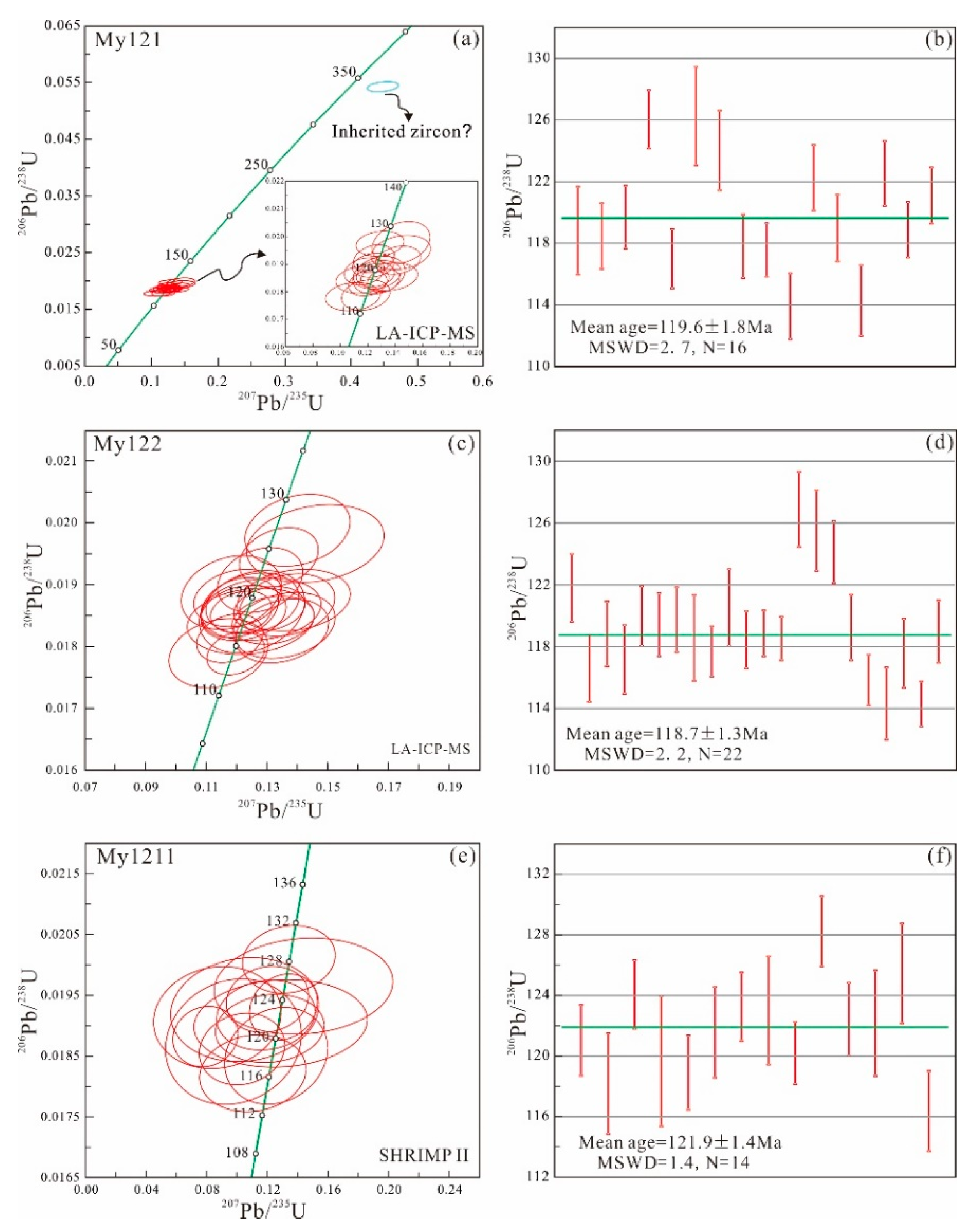
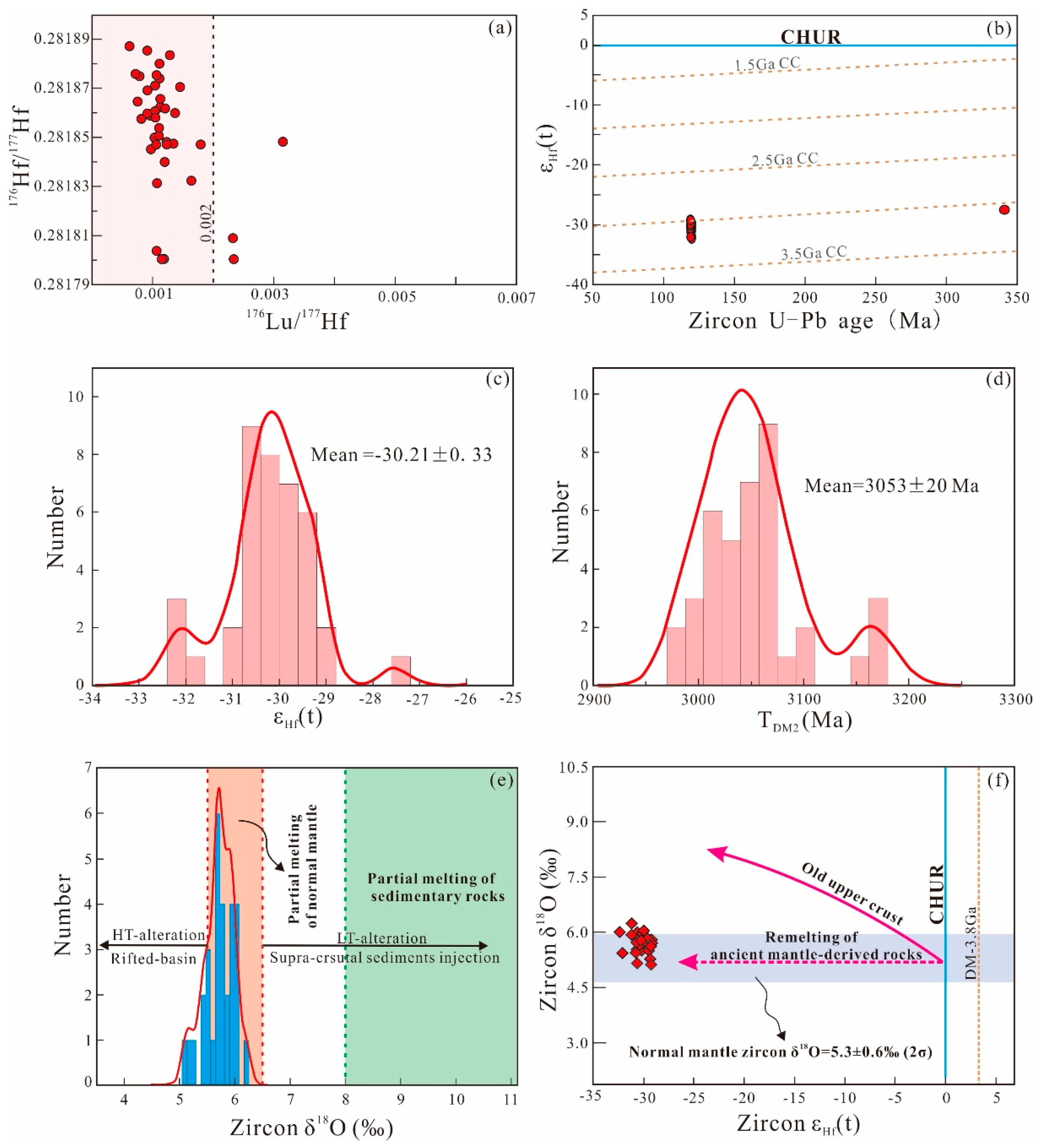
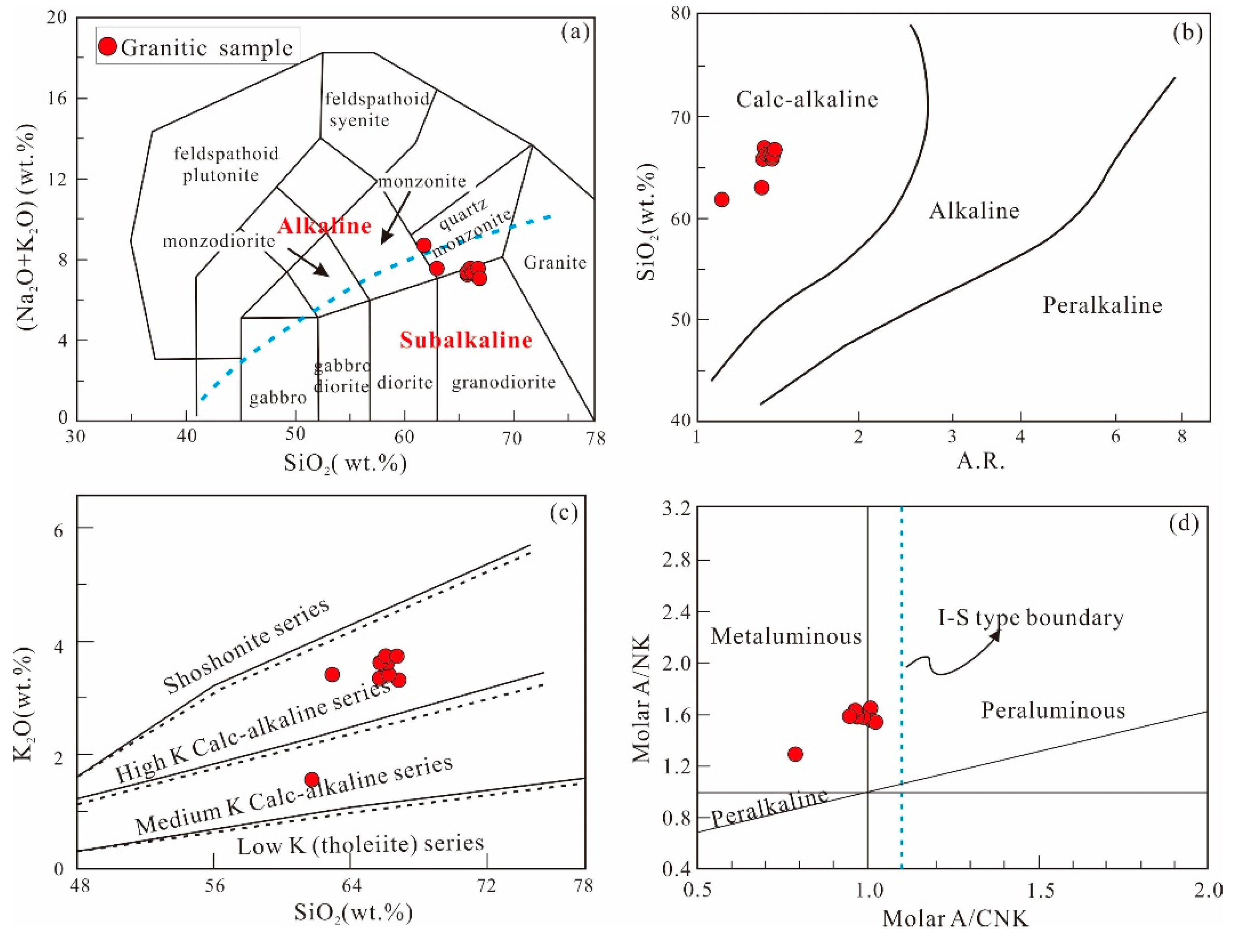
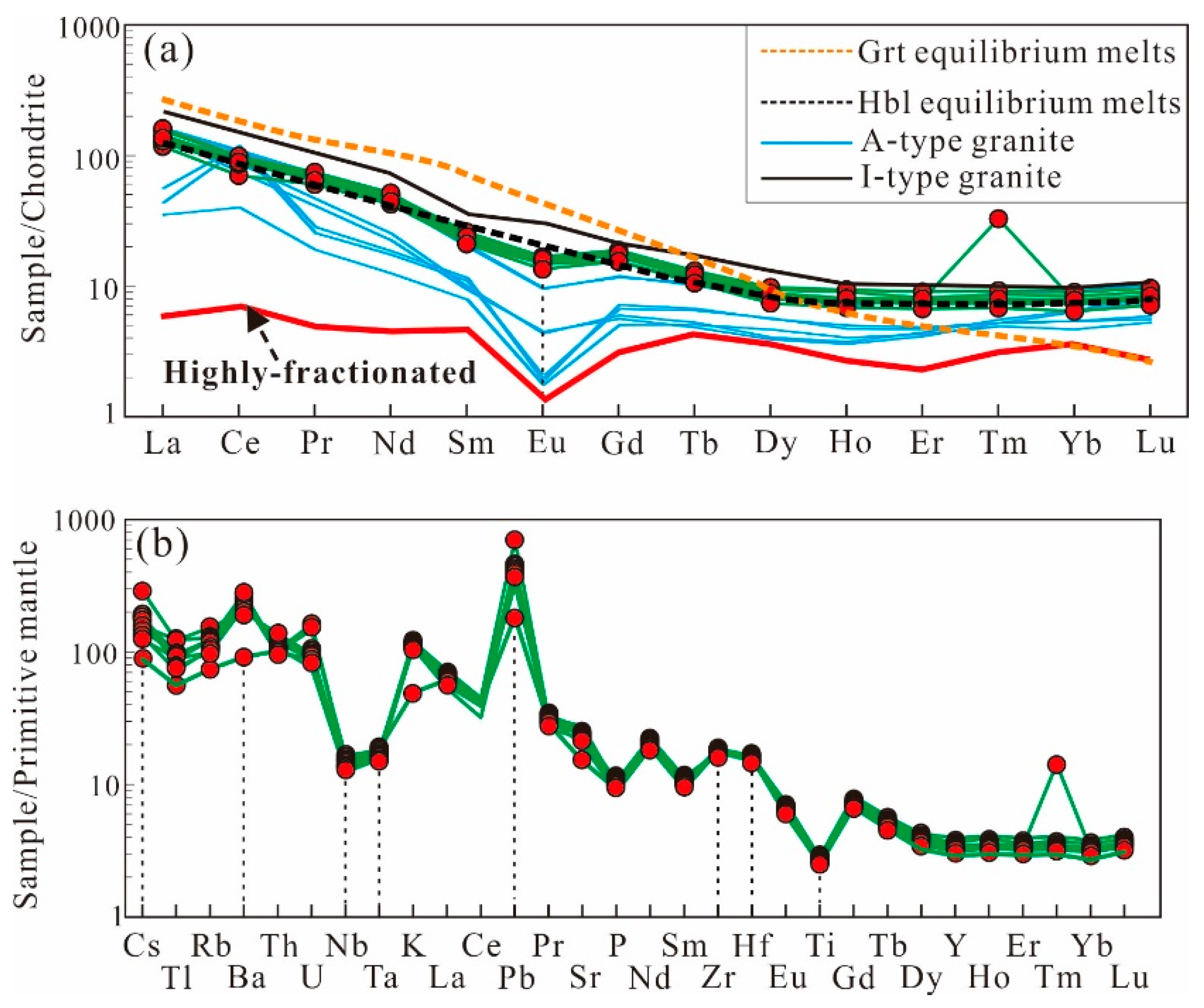
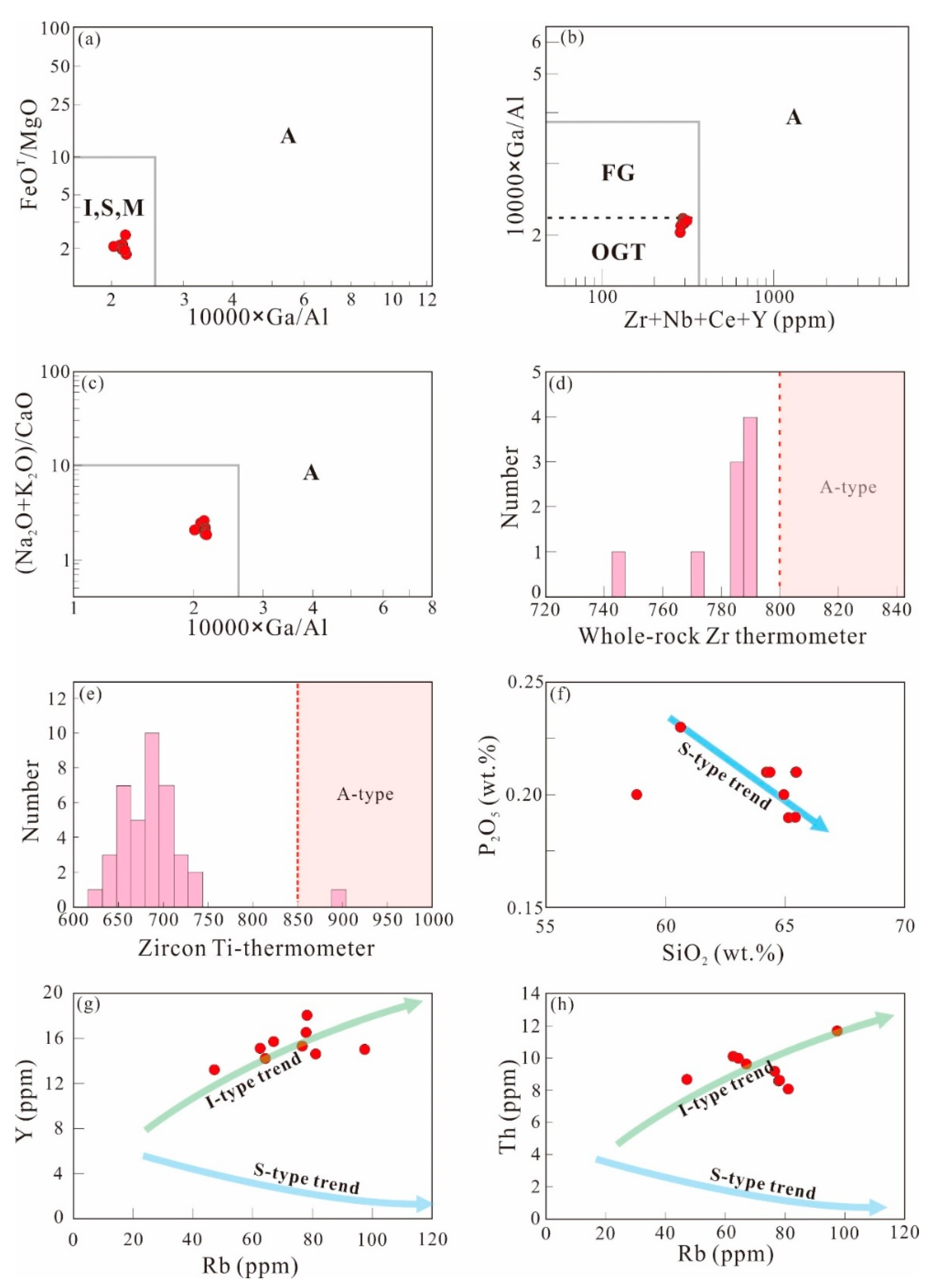
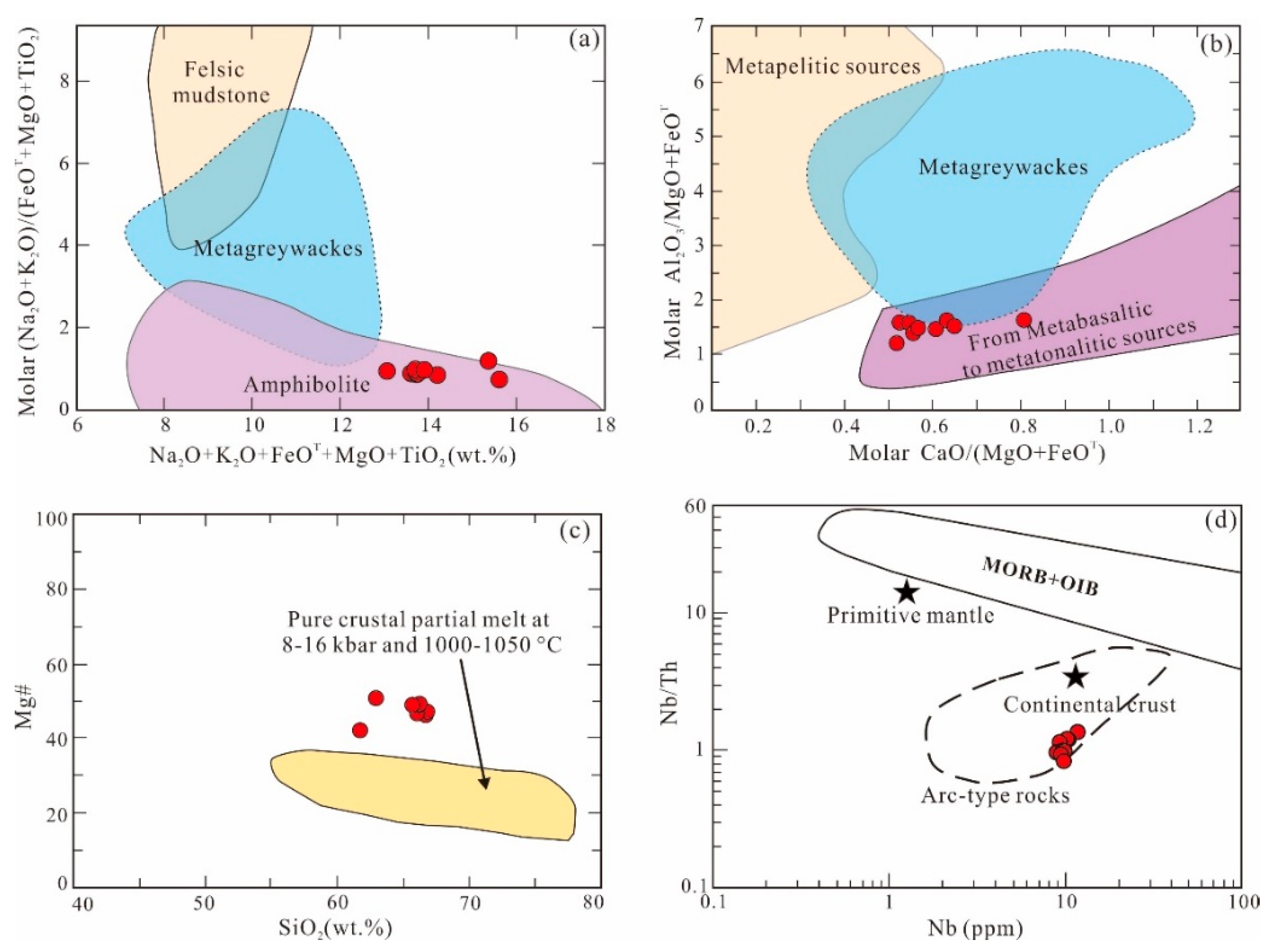
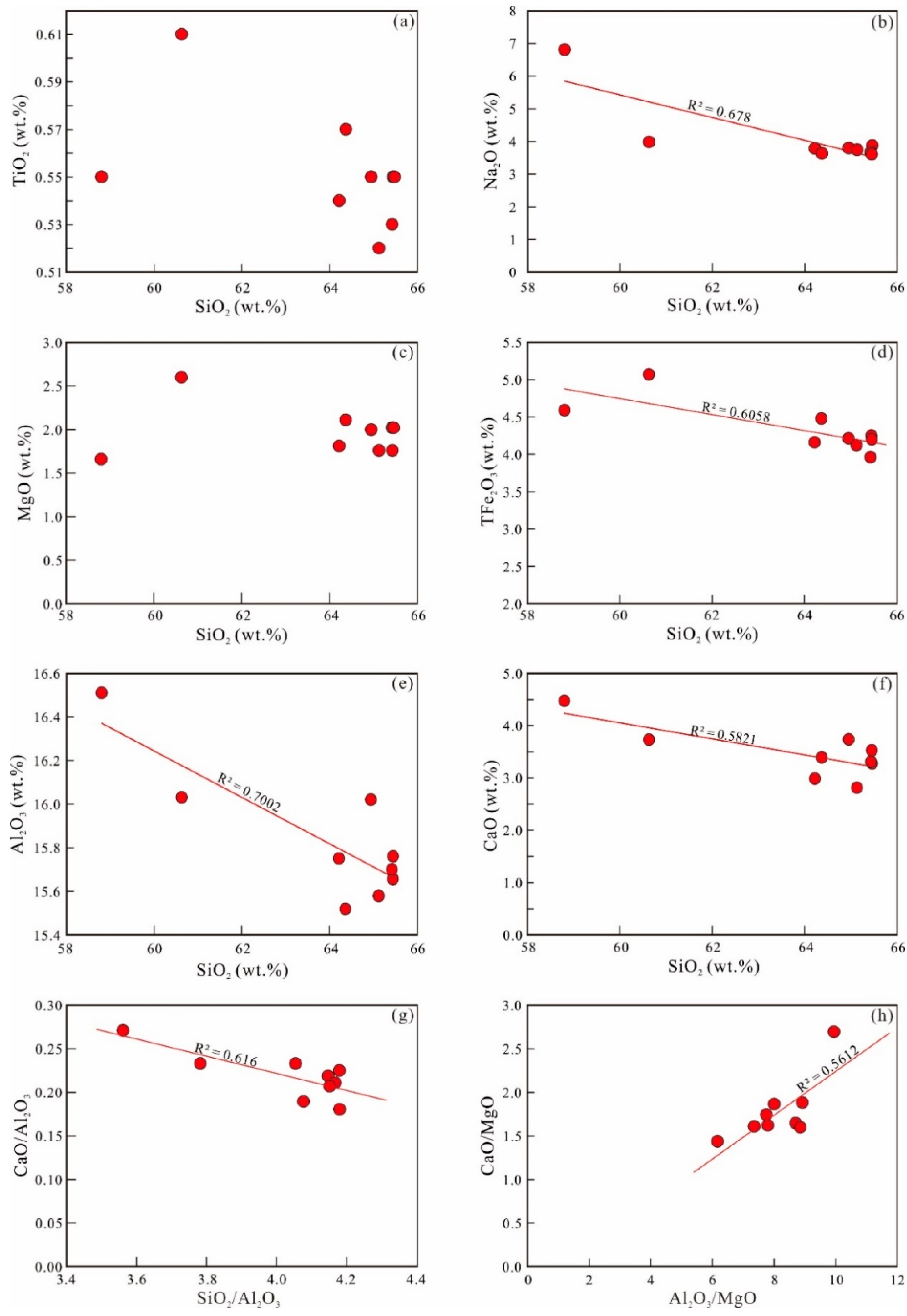
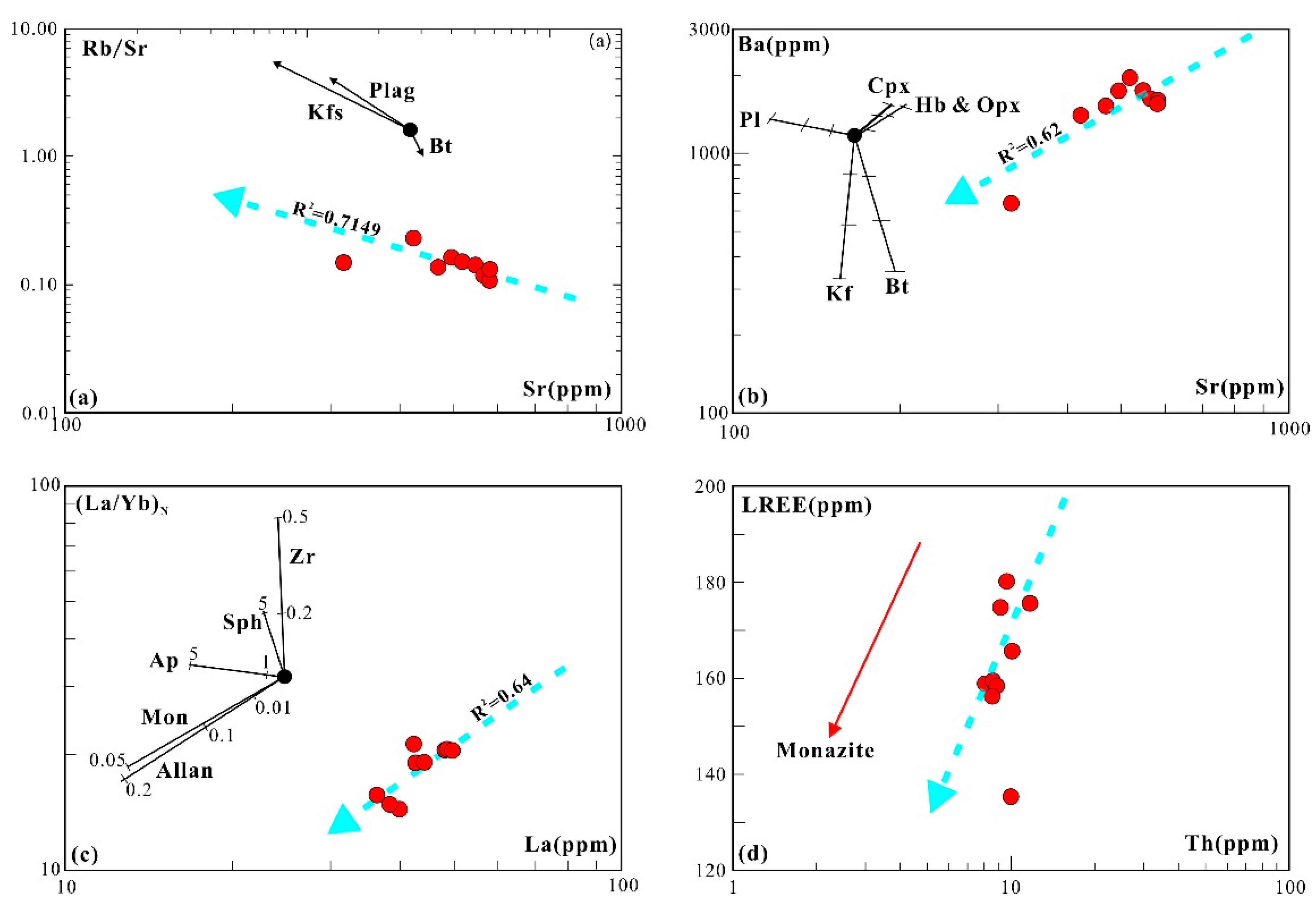
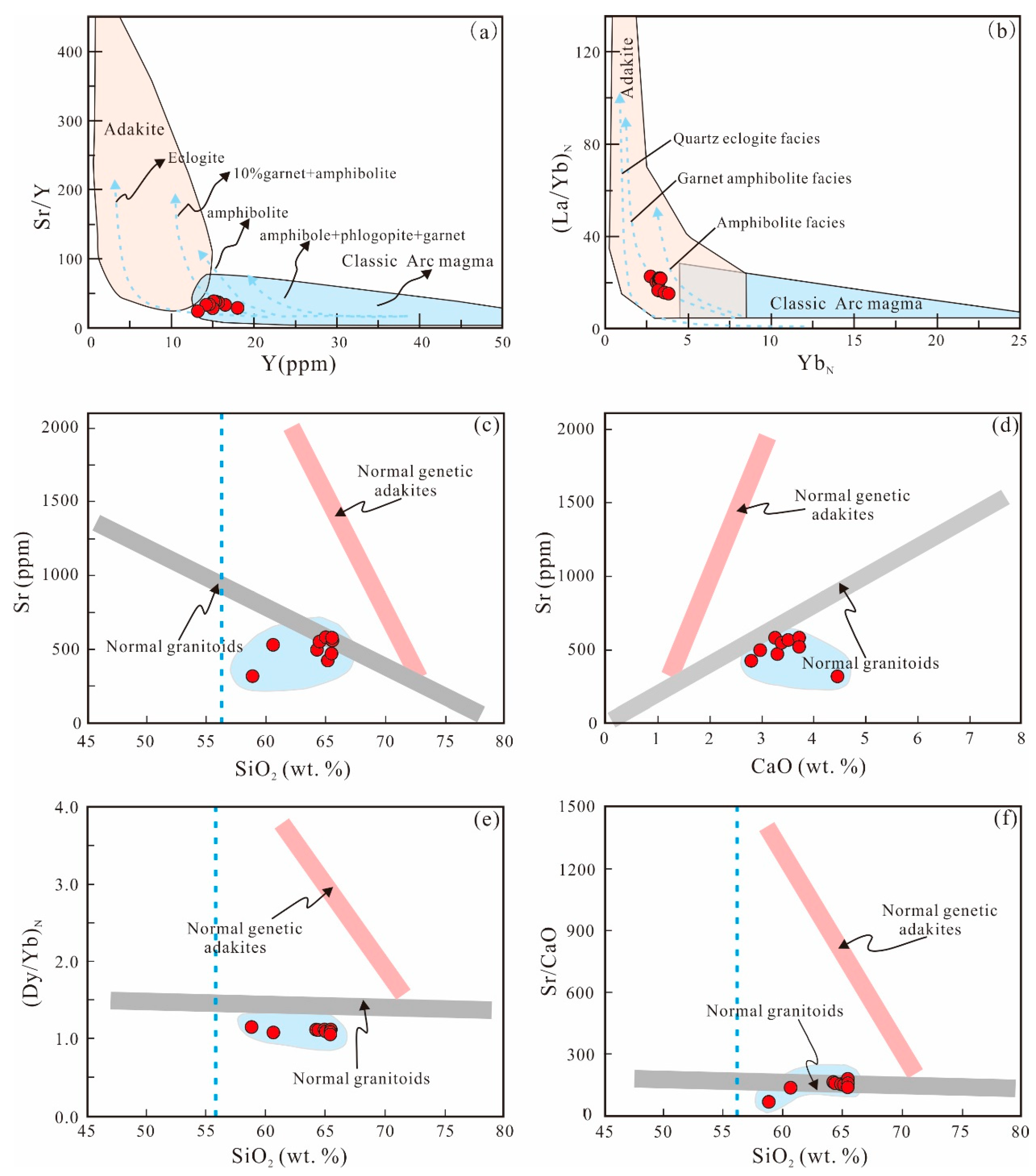
| Spot Number | Th | U | Th/U | Ti contents | °C | 207Pb/235U | 206Pb/238U | 206Pb/238U | Methods | |||
|---|---|---|---|---|---|---|---|---|---|---|---|---|
| Ratio | 1σ | Ratio | 1σ | Age (Ma) | 1σ | |||||||
| My1-2-1-01 | 169 | 142 | 1.19 | 4.68 | 679 | 0.12810 | 0.01257 | 0.01860 | 0.00045 | 118.8 | 2.8 | I |
| My1-2-1-02 | 168 | 118 | 1.42 | 7.70 | 722 | 0.13558 | 0.01369 | 0.01855 | 0.00034 | 118.5 | 2.1 | I |
| My1-2-1-04 | 229 | 173 | 1.32 | 6.76 | 710 | 0.11745 | 0.00955 | 0.01874 | 0.00032 | 119.7 | 2.1 | I |
| My1-2-1-05 | 405 | 200 | 2.02 | 4.12 | 669 | 0.12890 | 0.01153 | 0.01975 | 0.00030 | 126.1 | 1.9 | I |
| My1-2-1-06 | 252 | 375 | 0.67 | 7.44 | 719 | 0.44894 | 0.01570 | 0.05428 | 0.00058 | 340.8 | 3.5 | I |
| My1-2-1-08 | 189 | 168 | 1.12 | 3.55 | 657 | 0.11994 | 0.00922 | 0.01832 | 0.00030 | 117.0 | 1.9 | I |
| My1-2-1-09 | 169 | 115 | 1.47 | 2.91 | 642 | 0.14438 | 0.01395 | 0.01978 | 0.00051 | 126.2 | 3.2 | I |
| My1-2-1-10 | 176 | 137 | 1.28 | 7.31 | 717 | 0.14420 | 0.01435 | 0.01943 | 0.00041 | 124.0 | 2.6 | I |
| My1-2-1-11 | 175 | 133 | 1.32 | 3.36 | 653 | 0.11603 | 0.01281 | 0.01844 | 0.00033 | 117.8 | 2.1 | I |
| My1-2-1-12 | 512 | 247 | 2.07 | 5.87 | 698 | 0.13140 | 0.00787 | 0.01841 | 0.00027 | 117.6 | 1.7 | I |
| My1-2-1-13 | 288 | 195 | 1.47 | 3.79 | 662 | 0.10897 | 0.01315 | 0.01783 | 0.00034 | 113.9 | 2.1 | I |
| My1-2-1-14 | 159 | 137 | 1.17 | 4.13 | 669 | 0.14210 | 0.01081 | 0.01914 | 0.00034 | 122.2 | 2.1 | I |
| My1-2-1-15 | 198 | 127 | 1.56 | 38.98 | 892 | 0.12686 | 0.01149 | 0.01863 | 0.00034 | 119.0 | 2.2 | I |
| My1-2-1-16 | 213 | 118 | 1.80 | 5.05 | 685 | 0.11850 | 0.01170 | 0.01789 | 0.00036 | 114.3 | 2.3 | I |
| My1-2-1-17 | 216 | 150 | 1.44 | 3.42 | 654 | 0.12453 | 0.00984 | 0.01919 | 0.00033 | 122.5 | 2.1 | I |
| My1-2-1-18 | 300 | 187 | 1.60 | 3.74 | 661 | 0.12557 | 0.00921 | 0.01861 | 0.00028 | 118.9 | 1.8 | I |
| My1-2-1-19 | 212 | 175 | 1.22 | 5.05 | 685 | 0.12392 | 0.01002 | 0.01896 | 0.00029 | 121.1 | 1.8 | I |
| My1-2-2-01 | 210 | 142 | 1.48 | 5.78 | 697 | 0.12784 | 0.00926 | 0.01907 | 0.00035 | 121.8 | 2.2 | I |
| My1-2-2-02 | 152 | 128 | 1.18 | 6.21 | 703 | 0.13503 | 0.01014 | 0.01825 | 0.00034 | 116.6 | 2.2 | I |
| My1-2-2-03 | 136 | 117 | 1.16 | 5.10 | 686 | 0.12819 | 0.01301 | 0.01860 | 0.00033 | 118.8 | 2.1 | I |
| My1-2-2-04 | 184 | 143 | 1.29 | 5.26 | 689 | 0.13567 | 0.01109 | 0.01834 | 0.00035 | 117.2 | 2.2 | I |
| My1-2-2-05 | 356 | 180 | 1.97 | 2.53 | 631 | 0.12047 | 0.00956 | 0.01878 | 0.00031 | 120.0 | 1.9 | I |
| My1-2-2-06 | 184 | 150 | 1.23 | 6.40 | 705 | 0.12527 | 0.01013 | 0.01870 | 0.00032 | 119.4 | 2.0 | I |
| My1-2-2-07 | 287 | 166 | 1.73 | 9.75 | 743 | 0.13883 | 0.01232 | 0.01875 | 0.00033 | 119.7 | 2.1 | I |
| My1-2-2-08 | 76 | 66 | 1.16 | 2.82 | 639 | 0.12512 | 0.01145 | 0.01856 | 0.00044 | 118.6 | 2.8 | I |
| My1-2-2-09 | 385 | 217 | 1.78 | 3.75 | 661 | 0.13204 | 0.00892 | 0.01842 | 0.00026 | 117.7 | 1.6 | I |
| My1-2-2-10 | 116 | 110 | 1.05 | 5.46 | 692 | 0.11826 | 0.01086 | 0.01887 | 0.00039 | 120.5 | 2.5 | I |
| My1-2-2-11 | 267 | 184 | 1.45 | 5.15 | 687 | 0.12233 | 0.00926 | 0.01854 | 0.00029 | 118.4 | 1.9 | I |
| My1-2-2-12 | 873 | 309 | 2.82 | 4.23 | 671 | 0.13081 | 0.00775 | 0.01861 | 0.00023 | 118.9 | 1.5 | I |
| My1-2-2-13 | 625 | 303 | 2.06 | 5.72 | 696 | 0.12159 | 0.00668 | 0.01856 | 0.00022 | 118.5 | 1.4 | I |
| My1-2-2-15 | 100 | 102 | 0.99 | 5.50 | 693 | 0.14010 | 0.01142 | 0.01988 | 0.00039 | 126.9 | 2.4 | I |
| My1-2-2-16 | 148 | 114 | 1.30 | 9.52 | 741 | 0.14599 | 0.01492 | 0.01966 | 0.00041 | 125.5 | 2.6 | I |
| My1-2-2-18 | 535 | 225 | 2.38 | 4.79 | 681 | 0.13395 | 0.00859 | 0.01944 | 0.00032 | 124.1 | 2.0 | I |
| My1-2-2-19 | 567 | 263 | 2.15 | 6.36 | 705 | 0.13667 | 0.01036 | 0.01867 | 0.00033 | 119.2 | 2.1 | I |
| My1-2-2-20 | 463 | 231 | 2.00 | 3.92 | 665 | 0.11782 | 0.00720 | 0.01813 | 0.00026 | 115.8 | 1.6 | I |
| My1-2-2-21 | 133 | 120 | 1.12 | 3.54 | 657 | 0.11409 | 0.01077 | 0.01789 | 0.00037 | 114.3 | 2.3 | I |
| My1-2-2-22 | 178 | 140 | 1.27 | 6.33 | 705 | 0.12465 | 0.01378 | 0.01841 | 0.00035 | 117.6 | 2.2 | I |
| My1-2-2-23 | 231 | 356 | 0.65 | 2.76 | 638 | 0.11978 | 0.00629 | 0.01789 | 0.00023 | 114.3 | 1.5 | I |
| My1-2-2-26 | 258 | 181 | 1.43 | 5.04 | 685 | 0.12105 | 0.00848 | 0.01863 | 0.00032 | 119.0 | 2.0 | I |
| MY1211-1.1 | 138 | 133 | 1.04 | / | / | 0.16380 | 0.00056 | 0.02021 | 0.00018 | 129.0 | 2.3 | II |
| MY1211-1.2 | 221 | 198 | 1.11 | / | / | 0.12200 | 0.0019 | 0.01896 | 0.00019 | 121.1 | 2.3 | II |
| MY1211-1.3 | 200 | 182 | 1.10 | / | / | 0.15200 | 0.0016 | 0.0202 | 0.00019 | 128.9 | 2.5 | II |
| MY1211-1.4 | 133 | 151 | 0.88 | / | / | 0.12600 | 0.0018 | 0.01851 | 0.00028 | 118.2 | 3.3 | II |
| MY1211-1.5 | 337 | 231 | 1.46 | / | / | 0.12000 | 0.0015 | 0.01944 | 0.00018 | 124.1 | 2.3 | II |
| MY1211-1.6 | 152 | 153 | 0.99 | / | / | 0.09800 | 0.003 | 0.01875 | 0.00036 | 119.8 | 4.3 | II |
| MY1211-1.7 | 427 | 275 | 1.55 | / | / | 0.10300 | 0.0018 | 0.01863 | 0.00021 | 119.0 | 2.5 | II |
| MY1211-1.8 | 169 | 150 | 1.13 | / | / | 0.12900 | 0.0029 | 0.01905 | 0.00025 | 121.6 | 3.0 | II |
| MY1211-1.9 | 247 | 210 | 1.18 | / | / | 0.13100 | 0.0011 | 0.01931 | 0.00019 | 123.3 | 2.3 | II |
| MY1211-1.10 | 172 | 162 | 1.06 | / | / | 0.10500 | 0.0031 | 0.01928 | 0.00029 | 123.1 | 3.5 | II |
| MY1211-1.11 | 258 | 211 | 1.23 | / | / | 0.07900 | 0.0018 | 0.01884 | 0.00017 | 120.3 | 2.1 | II |
| MY1211-1.12 | 402 | 238 | 1.69 | / | / | 0.13400 | 0.0015 | 0.0201 | 0.00018 | 128.3 | 2.3 | II |
| MY1211-1.13 | 219 | 189 | 1.16 | / | / | 0.15200 | 0.0013 | 0.02019 | 0.00019 | 128.9 | 2.4 | II |
| MY1211-1.14 | 139 | 155 | 0.90 | / | / | 0.11900 | 0.0018 | 0.01918 | 0.0002 | 122.5 | 2.4 | II |
| MY1211-1.15 | 228 | 170 | 1.34 | / | / | 0.08700 | 0.0032 | 0.01915 | 0.00029 | 122.3 | 3.5 | II |
| MY1211-1.16 | 136 | 152 | 0.90 | / | / | 0.14400 | 0.0027 | 0.01966 | 0.00026 | 125.5 | 3.3 | II |
| MY1211-1.17 | 420 | 271 | 1.55 | / | / | 0.11000 | 0.0021 | 0.01823 | 0.00023 | 116.4 | 2.6 | II |
| Spot Number | Age | 176Hf/177Hf | 1σ | 176Lu/177Hf | 1σ | 176Yb/177Hf | 1σ | IHf | εHf(t) | 1σ | fLu/Hf | TDM1 | 1σ | TDM2 | 1σ |
|---|---|---|---|---|---|---|---|---|---|---|---|---|---|---|---|
| My121-01 | 120 | 0.281840 | 0.000009 | 0.001198 | 0.000007 | 0.027346 | 0.000178 | 0.28184 | −30.43 | 0.32 | −0.96 | 1992 | 12 | 3084 | 19 |
| My121-02 | 120 | 0.281804 | 0.000009 | 0.001066 | 0.000004 | 0.024296 | 0.000079 | 0.28180 | −32.13 | 0.31 | −0.97 | 2036 | 12 | 3163 | 19 |
| My121-04 | 120 | 0.281848 | 0.000008 | 0.001230 | 0.000005 | 0.028240 | 0.000122 | 0.28185 | −30.57 | 0.30 | −0.96 | 1983 | 12 | 3066 | 18 |
| My121-05 | 120 | 0.281869 | 0.000009 | 0.000914 | 0.000014 | 0.021804 | 0.000406 | 0.28187 | −29.80 | 0.32 | −0.97 | 1938 | 13 | 3019 | 20 |
| My121-06 | 341 | 0.281801 | 0.000008 | 0.001190 | 0.000039 | 0.031458 | 0.001135 | 0.28179 | −27.51 | 0.30 | −0.96 | 2047 | 12 | 3042 | 18 |
| My121-08 | 120 | 0.281859 | 0.000009 | 0.000965 | 0.000006 | 0.021987 | 0.000117 | 0.28186 | −29.74 | 0.33 | −0.97 | 1954 | 13 | 3042 | 20 |
| My121-09 | 120 | 0.281875 | 0.000009 | 0.000785 | 0.000008 | 0.018712 | 0.000174 | 0.28187 | −29.59 | 0.33 | −0.98 | 1923 | 13 | 3006 | 20 |
| My121-10 | 120 | 0.281845 | 0.000009 | 0.000973 | 0.000013 | 0.022548 | 0.000282 | 0.28184 | −30.66 | 0.32 | −0.97 | 1974 | 12 | 3072 | 20 |
| My121-11 | 120 | 0.281847 | 0.000009 | 0.001342 | 0.000012 | 0.032351 | 0.000303 | 0.28184 | −30.60 | 0.33 | −0.96 | 1990 | 13 | 3068 | 20 |
| My121-12 | 120 | 0.281860 | 0.000010 | 0.001369 | 0.000007 | 0.032400 | 0.000172 | 0.28186 | −30.16 | 0.37 | −0.96 | 1974 | 15 | 3041 | 23 |
| My121-13 | 120 | 0.281800 | 0.000010 | 0.001151 | 0.000005 | 0.026790 | 0.000123 | 0.28180 | -31.82 | 0.35 | −0.97 | 2045 | 14 | 3171 | 22 |
| My121-14 | 120 | 0.281831 | 0.000009 | 0.001071 | 0.000001 | 0.024793 | 0.000044 | 0.28183 | −31.15 | 0.32 | −0.97 | 1998 | 12 | 3103 | 19 |
| My121-15 | 120 | 0.281850 | 0.000008 | 0.001030 | 0.000006 | 0.024307 | 0.000174 | 0.28185 | −30.49 | 0.29 | −0.97 | 1970 | 11 | 3062 | 18 |
| My121-16 | 120 | 0.281800 | 0.000011 | 0.002338 | 0.000043 | 0.056820 | 0.001104 | 0.28180 | −32.35 | 0.38 | −0.93 | 2111 | 15 | 3175 | 23 |
| My121-17 | 120 | 0.281847 | 0.000010 | 0.001233 | 0.000020 | 0.028555 | 0.000421 | 0.28184 | −30.61 | 0.37 | −0.96 | 1984 | 15 | 3069 | 23 |
| My121-18 | 120 | 0.281858 | 0.000009 | 0.000813 | 0.000002 | 0.019332 | 0.000029 | 0.28186 | −29.78 | 0.31 | −0.98 | 1948 | 12 | 3044 | 19 |
| My121-19 | 120 | 0.281862 | 0.000009 | 0.001128 | 0.000006 | 0.027226 | 0.000113 | 0.28186 | −30.06 | 0.31 | −0.97 | 1958 | 12 | 3035 | 19 |
| My122-01 | 119 | 0.281832 | 0.000009 | 0.001638 | 0.000021 | 0.039715 | 0.000564 | 0.28183 | −31.18 | 0.33 | −0.95 | 2027 | 13 | 3103 | 20 |
| My122-02 | 119 | 0.281860 | 0.000010 | 0.000915 | 0.000004 | 0.021709 | 0.000130 | 0.28186 | −30.16 | 0.35 | −0.97 | 1951 | 14 | 3040 | 21 |
| My122-03 | 119 | 0.281851 | 0.000009 | 0.001102 | 0.000009 | 0.025715 | 0.000200 | 0.28185 | −30.49 | 0.32 | −0.97 | 1973 | 13 | 3061 | 20 |
| My122-04 | 119 | 0.281847 | 0.000008 | 0.001058 | 0.000006 | 0.025040 | 0.000122 | 0.28184 | −30.19 | 0.29 | −0.97 | 1975 | 12 | 3069 | 18 |
| My122-05 | 119 | 0.281854 | 0.000009 | 0.001105 | 0.000018 | 0.026502 | 0.000496 | 0.28185 | −30.38 | 0.32 | −0.97 | 1968 | 13 | 3054 | 20 |
| My122-06 | 119 | 0.281884 | 0.000008 | 0.001285 | 0.000006 | 0.030369 | 0.000140 | 0.28188 | −29.34 | 0.29 | −0.96 | 1937 | 11 | 2989 | 18 |
| My122-07 | 119 | 0.281848 | 0.000010 | 0.003147 | 0.000051 | 0.078701 | 0.001352 | 0.28184 | −30.74 | 0.37 | −0.91 | 2088 | 16 | 3074 | 23 |
| My122-08 | 119 | 0.281880 | 0.000011 | 0.001113 | 0.000067 | 0.026345 | 0.001534 | 0.28188 | −29.46 | 0.38 | −0.97 | 1933 | 15 | 2997 | 23 |
| My122-09 | 119 | 0.281871 | 0.000009 | 0.001041 | 0.000015 | 0.024160 | 0.000300 | 0.28187 | −29.34 | 0.31 | −0.97 | 1941 | 12 | 3016 | 19 |
| My122-10 | 119 | 0.281865 | 0.000008 | 0.000753 | 0.000009 | 0.017240 | 0.000179 | 0.28186 | −29.97 | 0.30 | −0.98 | 1936 | 12 | 3029 | 18 |
| My122-11 | 119 | 0.281862 | 0.000009 | 0.001206 | 0.000021 | 0.028586 | 0.000564 | 0.28186 | −30.11 | 0.32 | −0.96 | 1963 | 13 | 3037 | 20 |
| My122-12 | 119 | 0.281871 | 0.000009 | 0.001453 | 0.000071 | 0.037634 | 0.001977 | 0.28187 | −29.82 | 0.34 | −0.96 | 1963 | 14 | 3019 | 21 |
| My122-13 | 119 | 0.281861 | 0.000008 | 0.001040 | 0.000005 | 0.024390 | 0.000134 | 0.28186 | −30.13 | 0.29 | −0.97 | 1956 | 12 | 3039 | 18 |
| My122-15 | 119 | 0.281874 | 0.000009 | 0.001114 | 0.000004 | 0.026054 | 0.000099 | 0.28187 | −29.24 | 0.30 | −0.97 | 1941 | 12 | 3010 | 19 |
| My122-16 | 119 | 0.281887 | 0.000009 | 0.000621 | 0.000024 | 0.014994 | 0.000592 | 0.28189 | −29.16 | 0.30 | −0.98 | 1898 | 12 | 2979 | 18 |
| My122-18 | 119 | 0.281875 | 0.000008 | 0.001066 | 0.000013 | 0.024323 | 0.000330 | 0.28187 | −29.62 | 0.29 | −0.97 | 1937 | 11 | 3007 | 18 |
| My122-19 | 119 | 0.281847 | 0.000012 | 0.001792 | 0.000014 | 0.043603 | 0.000350 | 0.28184 | −30.67 | 0.43 | −0.95 | 2014 | 17 | 3071 | 27 |
| My122-20 | 119 | 0.281858 | 0.000009 | 0.001045 | 0.000006 | 0.024099 | 0.000134 | 0.28186 | −30.23 | 0.31 | −0.97 | 1960 | 12 | 3044 | 19 |
| My122-21 | 119 | 0.281876 | 0.000009 | 0.000720 | 0.000007 | 0.016596 | 0.000204 | 0.28187 | −29.14 | 0.32 | −0.98 | 1919 | 12 | 3004 | 20 |
| My122-22 | 119 | 0.281866 | 0.000008 | 0.001126 | 0.000014 | 0.026669 | 0.000330 | 0.28186 | −29.96 | 0.27 | −0.97 | 1953 | 11 | 3028 | 17 |
| My122-23 | 119 | 0.281809 | 0.000010 | 0.002324 | 0.000056 | 0.057767 | 0.001431 | 0.28180 | −32.06 | 0.37 | −0.93 | 2098 | 15 | 3157 | 23 |
| My122-26 | 119 | 0.281885 | 0.000009 | 0.000911 | 0.000012 | 0.020823 | 0.000306 | 0.28188 | −29.25 | 0.31 | −0.97 | 1915 | 12 | 2984 | 19 |
| Sample Number | Zircon δ18O (‰) | 2σ |
|---|---|---|
| MY1211-1 | 5.53 | 0.20 |
| MY1211-10 | 6.00 | 0.21 |
| MY1211-11 | 5.50 | 0.16 |
| MY1211-12 | 6.24 | 0.17 |
| MY1211-13 | 5.85 | 0.15 |
| MY1211-14 | 6.01 | 0.24 |
| MY1211-15 | 5.16 | 0.26 |
| MY1211-16 | 5.68 | 0.20 |
| MY1211-17 | 5.99 | 0.18 |
| MY1211-18 | 5.93 | 0.16 |
| MY1211-19 | 5.68 | 0.14 |
| MY1211-2 | 5.68 | 0.18 |
| MY1211-20 | 5.66 | 0.14 |
| MY1211-21 | 5.79 | 0.24 |
| MY1211-22 | 5.44 | 0.18 |
| MY1211-23 | 5.50 | 0.29 |
| MY1211-24 | 5.27 | 0.21 |
| MY1211-25 | 5.92 | 0.16 |
| MY1211-26 | 5.94 | 0.20 |
| MY1211-27 | 5.76 | 0.14 |
| MY1211-28 | 5.97 | 0.21 |
| MY1211-29 | 5.12 | 0.18 |
| MY1211-3 | 5.79 | 0.20 |
| MY1211-30 | 5.83 | 0.23 |
| MY1211-4 | 5.72 | 0.12 |
| MY1211-5 | 5.78 | 0.22 |
| MY1211-6 | 5.70 | 0.16 |
| MY1211-7 | 6.04 | 0.20 |
| MY1211-8 | 5.43 | 0.18 |
| MY1211-9 | 5.62 | 0.23 |
| Sample Number | My1-2-1 | My1-2-2 | My1-2-3 | My1-2-4 | My1-2-4-1 | My1-2-5 | My1-2-6 | My1-2-7 | My1-2-8 |
|---|---|---|---|---|---|---|---|---|---|
| SiO2 | 64.37 | 65.43 | 65.13 | 64.95 | 64.22 | 60.63 | 65.46 | 65.45 | 58.80 |
| TiO2 | 0.57 | 0.53 | 0.52 | 0.55 | 0.54 | 0.61 | 0.55 | 0.55 | 0.55 |
| Al2O3 | 15.52 | 15.70 | 15.58 | 16.02 | 15.75 | 16.03 | 15.76 | 15.66 | 16.51 |
| TFe2O3 | 4.48 | 3.97 | 4.12 | 4.21 | 4.16 | 5.07 | 4.20 | 4.25 | 4.59 |
| Na2O | 3.63 | 3.67 | 3.74 | 3.79 | 3.78 | 3.98 | 3.87 | 3.60 | 6.80 |
| K2O | 3.56 | 3.25 | 3.65 | 3.31 | 3.64 | 3.29 | 3.37 | 3.58 | 1.49 |
| MgO | 2.11 | 1.76 | 1.76 | 2.00 | 1.81 | 2.60 | 2.02 | 2.02 | 1.66 |
| CaO | 3.39 | 3.31 | 2.81 | 3.73 | 2.98 | 3.73 | 3.27 | 3.52 | 4.47 |
| MnO | 0.11 | 0.12 | 0.15 | 0.07 | 0.14 | 0.18 | 0.12 | 0.07 | 0.17 |
| P2O5 | 0.21 | 0.19 | 0.19 | 0.20 | 0.21 | 0.23 | 0.21 | 0.21 | 0.20 |
| LOI | 1.62 | 2.16 | 2.75 | 0.57 | 2.6 | 3.47 | 1.51 | 0.89 | 4.51 |
| Total | 99.57 | 100.09 | 100.40 | 99.40 | 99.83 | 99.82 | 100.34 | 99.80 | 99.75 |
| Al | 83884 | 84875 | 84467 | 85816 | 85758 | 88080 | 84423 | 83818 | 91774 |
| Li | 13.00 | 15.80 | 19.50 | 10.40 | 15.70 | 25.70 | 16.90 | 10.20 | 5.07 |
| Be | 1.60 | 2.09 | 2.75 | 1.54 | 2.43 | 2.66 | 1.82 | 1.44 | 2.91 |
| Sc | 16.80 | 14.10 | 15.60 | 14.20 | 17.90 | 20.60 | 16.60 | 17.30 | 13.50 |
| Ti | 3547 | 3195 | 3207 | 3408 | 3378 | 3792 | 3406 | 3430 | 3504 |
| V | 74.70 | 67.10 | 67.80 | 69.20 | 67.70 | 87.30 | 72.40 | 70.60 | 61.50 |
| Cr | 24.10 | 20.80 | 20.40 | 23.30 | 20.80 | 60.80 | 23.00 | 21.70 | 19.60 |
| Mn | 921 | 972 | 1194 | 598 | 1082 | 1423 | 967 | 613 | 1291 |
| Co | 11.70 | 10.40 | 10.50 | 11.30 | 10.80 | 14.40 | 11.00 | 11.20 | 11.20 |
| Ni | 13.50 | 11.70 | 12.10 | 13.10 | 12.70 | 27.20 | 13.30 | 12.70 | 13.00 |
| Cu | 8.20 | 6.96 | 6.87 | 9.23 | 6.95 | 9.62 | 6.64 | 9.41 | 4.66 |
| Zn | 56.20 | 52.90 | 79.40 | 51.80 | 67.10 | 72.60 | 64.10 | 50.70 | 67.60 |
| Ga | 17.90 | 17.20 | 18.00 | 18.40 | 18.00 | 19.20 | 18.20 | 18.10 | 19.90 |
| Rb | 77.90 | 64.20 | 97.50 | 62.50 | 81.10 | 78.20 | 76.60 | 67.00 | 47.20 |
| Sr | 547 | 469 | 423 | 580 | 495 | 518 | 581 | 565 | 317 |
| Y | 16.50 | 14.20 | 15.00 | 15.10 | 14.60 | 18.00 | 15.30 | 15.70 | 13.20 |
| Zr | 205 | 201 | 197 | 198 | 195 | 197 | 198 | 208 | 202 |
| Nb | 10.10 | 9.84 | 9.74 | 9.41 | 9.24 | 11.70 | 8.85 | 9.61 | 10.40 |
| Mo | 0.52 | 0.70 | 1.86 | 0.35 | 0.44 | 1.05 | 1.11 | 0.41 | 0.26 |
| Cd | <0.030 | 0.03 | 0.14 | <0.030 | <0.030 | <0.030 | 0.04 | 0.03 | <0.030 |
| Sn | 1.18 | 1.08 | 1.22 | 1.13 | 1.34 | 1.48 | 1.27 | 1.13 | 6.03 |
| Cs | 1.37 | 1.53 | 2.29 | 0.98 | 1.24 | 1.45 | 1.19 | 1.05 | 0.70 |
| Ba | 1741 | 1518 | 1395 | 1540 | 1736 | 1944 | 1583 | 1614 | 640 |
| Hf | 5.08 | 5.10 | 4.94 | 4.76 | 4.66 | 5.00 | 4.77 | 5.13 | 4.91 |
| Ta | 0.74 | 0.72 | 0.72 | 0.67 | 0.65 | 0.75 | 0.64 | 0.71 | 0.77 |
| W | 0.22 | 0.30 | 0.77 | 0.17 | 0.77 | 0.40 | 0.27 | 0.15 | 0.87 |
| Tl | 0.44 | 0.38 | 0.61 | 0.45 | 0.62 | 0.48 | 0.47 | 0.36 | 0.28 |
| Pb | 26.90 | 27.00 | 50.00 | 22.60 | 26.00 | 32.50 | 26.30 | 23.10 | 13.10 |
| Bi | 0.10 | 0.12 | 0.13 | 0.04 | 0.20 | 0.13 | 0.07 | 0.04 | 0.51 |
| Th | 8.58 | 10.00 | 11.70 | 10.10 | 8.08 | 8.62 | 9.18 | 9.65 | 8.67 |
| U | 1.83 | 1.86 | 2.03 | 2.14 | 1.92 | 3.07 | 1.59 | 2.01 | 3.38 |
| La | 38.40 | 36.40 | 48.70 | 44.30 | 42.70 | 40.00 | 48.30 | 49.70 | 42.40 |
| Ce | 69.20 | 56.90 | 79.40 | 73.90 | 69.60 | 69.40 | 78.10 | 79.90 | 72.30 |
| Pr | 8.24 | 7.33 | 8.60 | 8.36 | 8.24 | 8.48 | 8.72 | 9.10 | 7.90 |
| Nd | 29.70 | 25.50 | 29.00 | 28.90 | 28.30 | 30.40 | 29.40 | 31.00 | 26.80 |
| Sm | 4.74 | 4.11 | 4.35 | 4.47 | 4.47 | 5.04 | 4.47 | 4.69 | 4.12 |
| Eu | 1.21 | 1.09 | 1.09 | 1.14 | 1.19 | 1.23 | 1.17 | 1.18 | 0.99 |
| Gd | 4.74 | 3.99 | 4.43 | 4.54 | 4.36 | 4.88 | 4.55 | 4.61 | 4.01 |
| Tb | 0.60 | 0.52 | 0.54 | 0.55 | 0.54 | 0.62 | 0.55 | 0.58 | 0.50 |
| Dy | 3.02 | 2.58 | 2.72 | 2.72 | 2.63 | 3.14 | 2.71 | 2.85 | 2.39 |
| Ho | 0.65 | 0.54 | 0.58 | 0.57 | 0.54 | 0.67 | 0.57 | 0.58 | 0.49 |
| Er | 1.71 | 1.55 | 1.64 | 1.59 | 1.54 | 1.90 | 1.66 | 1.68 | 1.41 |
| Tm | 0.28 | 0.25 | 1.06 | 0.25 | 0.24 | 0.30 | 0.25 | 0.26 | 0.22 |
| Yb | 1.75 | 1.57 | 1.60 | 1.57 | 1.52 | 1.88 | 1.59 | 1.64 | 1.34 |
| Lu | 0.29 | 0.26 | 0.27 | 0.26 | 0.25 | 0.31 | 0.26 | 0.27 | 0.23 |
| 10000Ga/Al | 2.13 | 2.03 | 2.13 | 2.14 | 2.10 | 2.18 | 2.16 | 2.16 | 2.17 |
| FeOT/MgO | 1.91 | 2.03 | 2.11 | 1.89 | 2.07 | 1.76 | 1.87 | 1.89 | 2.49 |
| Zr+Nb+Ce+Y | 300.8 | 281.9 | 301.1 | 296.4 | 288.4 | 296.1 | 300.3 | 313.2 | 297.9 |
| A/CNK | 0.97 | 1.01 | 1.02 | 0.96 | 1.01 | 0.95 | 0.99 | 0.97 | 0.79 |
| A/NK | 1.58 | 1.64 | 1.54 | 1.63 | 1.55 | 1.58 | 1.57 | 1.60 | 1.29 |
| Nb/Th | 1.18 | 0.98 | 0.83 | 0.93 | 1.14 | 1.36 | 0.96 | 1.00 | 1.20 |
| (La/Yb)N | 14.79 | 15.63 | 20.52 | 19.02 | 18.94 | 14.34 | 20.48 | 20.43 | 21.33 |
| Mg# | 49 | 47 | 46 | 49 | 47 | 51 | 49 | 49 | 42 |
| (K2O+Na2O)/CaO | 2.12 | 2.09 | 2.63 | 1.90 | 2.49 | 1.95 | 2.21 | 2.04 | 1.85 |
| K2O+Na2O | 7.19 | 6.92 | 7.39 | 7.10 | 7.42 | 7.27 | 7.24 | 7.18 | 8.29 |
| Sr/CaO | 161 | 142 | 151 | 155 | 166 | 139 | 178 | 161 | 71 |
| (Dy/Yb)N | 1.12 | 1.07 | 1.10 | 1.12 | 1.12 | 1.08 | 1.11 | 1.13 | 1.16 |
| Zr/Hf | 40.35 | 39.41 | 39.88 | 41.60 | 41.85 | 39.40 | 41.51 | 40.55 | 41.14 |
| Rb/Sr | 0.14 | 0.14 | 0.23 | 0.11 | 0.16 | 0.15 | 0.13 | 0.12 | 0.15 |
| Sr/Y | 33.15 | 33.03 | 28.20 | 38.41 | 33.90 | 28.78 | 37.97 | 35.99 | 24.02 |
| SiO2/Al2O3 | 4.15 | 4.17 | 4.18 | 4.05 | 4.08 | 3.78 | 4.15 | 4.18 | 3.56 |
| Al2O3/MgO | 7.36 | 8.92 | 8.85 | 8.01 | 8.70 | 6.17 | 7.80 | 7.75 | 9.95 |
| CaO/Al2O3 | 0.22 | 0.21 | 0.18 | 0.23 | 0.19 | 0.23 | 0.21 | 0.22 | 0.27 |
| A.R. | 1.38 | 1.33 | 1.40 | 1.33 | 1.39 | 1.32 | 1.35 | 1.37 | 1.11 |
| Al2O3/(MgO+FeOT) | 1.40 | 1.64 | 1.60 | 1.53 | 1.59 | 1.22 | 1.50 | 1.48 | 1.64 |
| CaO/(MgO+FeOT) | 0.56 | 0.63 | 0.53 | 0.65 | 0.55 | 0.52 | 0.57 | 0.61 | 0.81 |
| Molar (N+K)/(F+M+T) | 0.83 | 0.94 | 0.97 | 0.88 | 0.96 | 0.73 | 0.89 | 0.87 | 1.19 |
| N+K+F+M+T | 14.19 | 13.05 | 13.70 | 13.60 | 13.90 | 15.61 | 13.75 | 13.72 | 15.36 |
| YbN | 8.37 | 7.51 | 7.66 | 7.51 | 7.27 | 9.00 | 7.61 | 7.85 | 6.41 |
| LREE/HREE | 11.62 | 11.66 | 13.33 | 13.37 | 13.30 | 11.28 | 14.02 | 14.08 | 14.59 |
| ∑REE | 164.53 | 142.59 | 183.98 | 173.12 | 166.12 | 168.25 | 182.30 | 188.04 | 165.10 |
| LREE | 156.23 | 135.32 | 175.57 | 165.61 | 158.86 | 159.43 | 174.71 | 180.18 | 158.52 |
| Eu/Eu* | 0.78 | 0.82 | 0.76 | 0.77 | 0.82 | 0.76 | 0.79 | 0.78 | 0.74 |
| CIPW calculated results (%) | |||||||||
| Ab | 31.00 | 31.16 | 31.66 | 32.41 | 32.19 | 33.92 | 32.79 | 30.67 | 57.96 |
| Or | 21.23 | 19.27 | 21.58 | 19.77 | 21.65 | 19.58 | 19.94 | 21.30 | 8.87 |
| An | 15.68 | 15.23 | 12.70 | 17.10 | 13.50 | 16.27 | 15.70 | 16.10 | 10.20 |
| Plagioclase An number | 32 | 32 | 27 | 33 | 28 | 31 | 31 | 33 | 14 |
© 2020 by the authors. Licensee MDPI, Basel, Switzerland. This article is an open access article distributed under the terms and conditions of the Creative Commons Attribution (CC BY) license (http://creativecommons.org/licenses/by/4.0/).
Share and Cite
Meng, Y.; Wang, Z.; Gan, B.; Liu, J. Petrogenesis and Tectonic Implications of the Early Cretaceous Granitic Pluton in the Sulu Orogenic Belt: The Caochang Granitic Pluton as an Example. Minerals 2020, 10, 432. https://doi.org/10.3390/min10050432
Meng Y, Wang Z, Gan B, Liu J. Petrogenesis and Tectonic Implications of the Early Cretaceous Granitic Pluton in the Sulu Orogenic Belt: The Caochang Granitic Pluton as an Example. Minerals. 2020; 10(5):432. https://doi.org/10.3390/min10050432
Chicago/Turabian StyleMeng, Yuanku, Zhongbo Wang, Baoping Gan, and Jinqing Liu. 2020. "Petrogenesis and Tectonic Implications of the Early Cretaceous Granitic Pluton in the Sulu Orogenic Belt: The Caochang Granitic Pluton as an Example" Minerals 10, no. 5: 432. https://doi.org/10.3390/min10050432
APA StyleMeng, Y., Wang, Z., Gan, B., & Liu, J. (2020). Petrogenesis and Tectonic Implications of the Early Cretaceous Granitic Pluton in the Sulu Orogenic Belt: The Caochang Granitic Pluton as an Example. Minerals, 10(5), 432. https://doi.org/10.3390/min10050432




